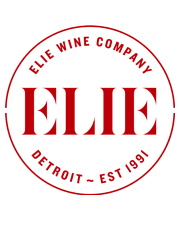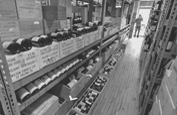Modest But Fully Realized Burgundy: A Producer’s Quest For Authenticity and Identity in Côte d’Or’s Most Northerly Commune: Marsanny (6-Bottle Pack $281)
Within Burgundy’s hierarchy, Marsannay is a fairly new invention. The northernmost commune in Burgundy’s heart only achieved Village status in 1987; prior to that, its grapes were restricted to use in regional wine. Suffice to say that the growing pains of such a phenomenon may take decades, and to date, Marsannay contains none of the storied Grand or Premier Crus in the carefully delineated Burgundy classification system.
And this is good news for bargain hunters. In Burgundy most emphatically, wine prices are set on reputation as much as anything else. As such, Marsannay wines represent unparalleled value, especially since many individual estates have forged new commitments to improve what history and nature has provided.

This week’s wine package contains representative examples of this quality surge from a small, family-run winery, Domaine Collotte as well as some additional labels that have produced an ever-improving roster of Marsannay gems.
Marsannay: Modest But Fully Realized Burgundy
Located just above Fixin and Brochon, just beyond the Dijon, Marsannay is composed of three villages—Couchey, Chenove and Marsannay-la-Côte. Of the 514 acres under vine, 445 are planted to red grape varieties (nearly all of it Pinot Noir) and 69 acres are dedicated to white grape varieties, mostly Chardonnay. These vines extend from north to south along the best section of the slope at elevations range from between 830 and 1300 feet, where terroir is a vine-friendly blend of shallow limestone soils, clay and silt.
Marsannay is the only Village-level appellation entitled to produce wines in red, white and rosé, making it a fully-realized Burgundy capable of showcasing the richness of Burgundy’s palette.
The Rehabilitation of Marsannay
Having been offered an upgraded seat in Burgundy’s Villages section, Marsannay has set to work ensuring that it remains worthy of the promotion. Many people still think of it as primarily rosé country, and there is no reason for it to entirely shed this reputation: Marsannay still produces amazing pink wines.
With new status comes heightened responsibilities, and winemakers in Marsannay find themselves with both the need and the means to rehabilitate reputations once maligned in the Côte de Nuits. Beyond technical improvements and state-of-the-art equipment, new theories about working the soil, machines for optical sorting and for pressing and maturing wine, human investments in both field and cellar.
Fight for Recognition: Pinotism Reigns
‘Pinotism’ is a term coined by the great Andrew Jeffords in describing the cult-like affection that Burgundy lovers have for their pet Pinot Noir, a finicky, difficult-to-ripen grape that commands loyalty like no other red wine variety. This phenomenon is due, in part, to the elusive mystery of its rocks-and-roses sensuality and also—paradoxically—because the opposite is also true: Pinot Noir can appear as a sparkling, white, red or rosé; it goes with nearly everything, salmon to steak, which explains its popularity in restaurants.
In Marsannay—a village once known for its Gamay—Pinot Noir is now the most widely planted grape, as integral to rosé (which also contains Pinot Gris and around 10% Chardonnay and Pinot Blanc) as it is to the robust reds of Chenove and Couchey.
Domaine Collotte
Located on Rue de Mazy, Marsannay’s ‘high street’, Domaine Collotte shares a headquarters with Domaine Fougeray de Beauclair, owned by a Collotte cousin. Formerly under the control of Philippe Collotte, his daughter Isabelle—having completed her viticulture studies—has joined her father in the domain and specializes in making the family’s superb Marsannay Blancs.
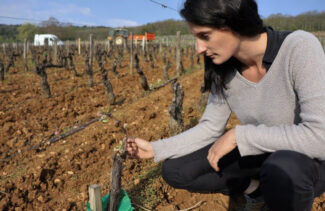
Isabelle Collotte, Domaine Collotte
Isabelle entered the business with plenty to work with: Covering about forty acres, mainly in Marsannay but with small plots in Fixin, Gevrey and Chambolle, Domaine Collotte draws mainly from vines over fifty years old and farms one lieu-dit planted in 1947. Among the innovations she has insisted upon involves selling less wine in bulk, which was a practice of her father.
In addition, she has embraced a holistic view of vineyard work: “Plowing is the norm here, no herbicides,” she says. “The grapes are triaged at the winery before 100% destemming into concrete tanks with one week of cool maceration. We love the thermal stability of concrete so there is a little pigeage early in fermentation and later only remontage. The color is ‘fixed’ with a short period at 35°C where the wine slowly cooling in the tank before a pneumatic press and then into barrels.”

Phillipe adds, “The common thread running through Domaine Collotte is an intimate link, our visceral attachment to Marsannay. For over 100 years, each generation of the Collotte family has dedicated its life to this village and its vineyards. Even if some of our parcels are located in Chambolle-Musigny, Fixin or Gevrey-Chambertin, it is in Marsannay-la-Côte that the heart of Domaine Collotte beats. Clos de Jeu, Champ Salomon, Boivin, Grasses Têtes, Combereau are a few of the Climats de Marsannay that plunge us daily into history by domain that is eminently proud of its roots.”
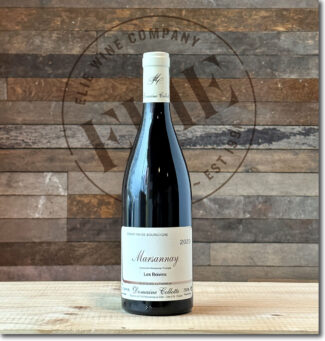 •1• Domaine Collotte, 2020 Marsannay ‘Les Boivins’ ($46)
•1• Domaine Collotte, 2020 Marsannay ‘Les Boivins’ ($46)
Les Boivins is a small lieu-dit that sits at the top of the slope just west of Marsannay where soils are clay and limestone. Boivins is known for sturdier wines than those produced in neighboring climats like Les Longeroies, which is five times its size. This wine comes from vines that are around half a century old. Like most of Domaine Collotte’s vineyard-specific wines, it sees 25% new oak to mellow the tannins and shows notes of blackberry, cherry, vanilla, clove, cedar, sage and earth.
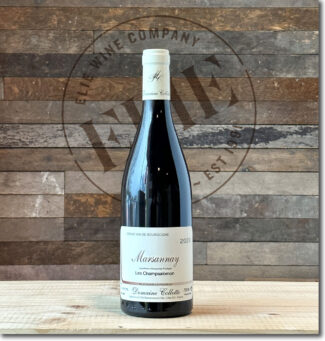 •2• Domaine Collotte, 2020 Marsannay ‘Les Champsalomon’ ($46)
•2• Domaine Collotte, 2020 Marsannay ‘Les Champsalomon’ ($46)
Champsalomon is tiny, only a little over an acre in total, where soils are predominantly limestone and Ostrea Acuminata marl. This 100% Pinot Noir hails from vines that have passed their fiftieth birthday, producing richly concentrated juice resplendent with cherry, spices, licorice and crushed rocks layered toward a powerful, focused finish. Domaine Collotte also produces a Champsalomon Blanc, made in part with Chardonnay Rosé—an extremely rare pink-berried mutation of Chardonnay.
 •3• Domaine Collotte, 2020 Marsannay ‘Les Grasses Têtes’ ($46)
•3• Domaine Collotte, 2020 Marsannay ‘Les Grasses Têtes’ ($46)
Les Grasses Têtes (translating to ‘fat heads’ in reference to the large outcroppings of bedrock) is a 20 acre, east-facing lieu-dit that stretches from the houses in the village to the top of the slope, with an average gradient of 10%. With a bit more clay in the otherwise classic limestone soils, these wines are generally a bit more plush and fruit-forward, requiring less cellar age to come into their own. Collotte’s 2020 shows perfumed aromas of cherry preserves, smoky minerals, exotic spices and bacon fat braced by a spine of juicy acidity.
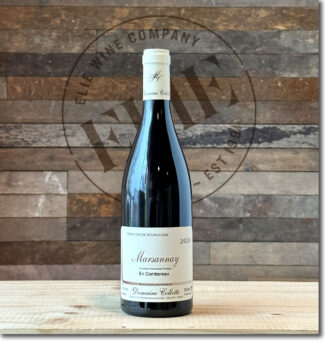 •4• Domaine Collotte, 2020 Marsannay ‘En Combereau’ ($47)
•4• Domaine Collotte, 2020 Marsannay ‘En Combereau’ ($47)
50-year-old vines from the En Combereau climat, where the roots penetrate into a Crinoidal limestone soil atop hard bedrock. The vineyard is tended organically and produces a seductive Pinot Noir with a bouquet of cherry, earth, truffle, and dried mushrooms; soft and silken on the palate, with warm, delicate red fruit, alongside notes of flowers and sweet spice.
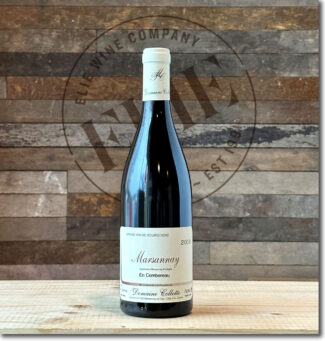 •5• Domaine Collotte, 2018 Marsannay ‘En Combereau’ ($41)
•5• Domaine Collotte, 2018 Marsannay ‘En Combereau’ ($41)
‘En Combereau’ one of the climats in Marsannay expected to eventually become a Premier Cru. This terroir, ideally located mid-slope on clay-limestone soils, produces wines that stand out for their density and depth but also for their elegance. Marked by its Côte de Nuits character, this wine shows an intense nose of blackcurrant, raspberry and undergrowth. Its rounded mouthfeel is shrouded in velvety tannins with a spark of anise on the finish.
Fixin: The Twin Commune
Fixin is the crème in an Oreo cookie formed by Marsannay to the north and Gevrey-Chambertin to the south; it boasts a superb terroir and unlike Marsannay, it contains six Premier Cru vineyards—La Perrière, Clos du Chapître, Arvelets, Clos Napoléon, Le Meix-Bas and Hervelets. Soils are similar, with homogenous brown limestone exploited best in exposures running east to south-east. Some vineyard plots (Hervelets, for example) have more marl, and those wines are predictably heavier and longer-lived.
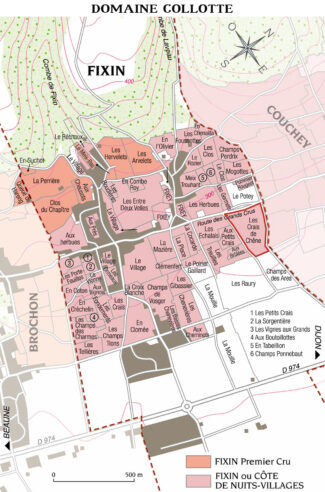
Fixin is solidly red wine country; Pinot Noir accounts for 96% of total production. Chardonnay and Pinot Blanc are also grown in small quantities, whereas Pinot Gris was decommissioned in 2011. Although the legislation permits up to 15% of Chardonnay and Pinot Blanc to be used as accessory grapes in red wines, this is rarely done. The few white wines are generally made entirely of Chardonnay, although blending with Pinot Blanc is permitted. Not much Fixin Blanc makes it out of the appellation; it remains a locally-kept, locally-consumed secret.
Fixin Pinot Noir is often referred to as a ‘winter wine’ because they are rarely ready to drink upon release. Deep purple (‘deep mid-red’ in Burgundian terms), they are floral on the nose with violet and peony at the forefront of the bouquet and currant, cherry and quince on the palate. With bottle-age, they take on animal scents of musk and leather.
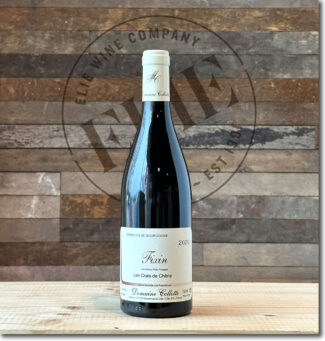 •6• Domaine Collotte, 2020 ‘Cuvée Vieilles Vignes’ Fixin ‘Les Crais de Chêne’ ($55)
•6• Domaine Collotte, 2020 ‘Cuvée Vieilles Vignes’ Fixin ‘Les Crais de Chêne’ ($55)
Crais de Chêne is a four-acre lieu-dit that lies on the alluvial cone between the villages of Couchey and Fixin. The plot is composed of limestone soils mixed with clay, and the vine age is approaching sixty years. Beefy and muscular, the wine shows the pedigree of much pricier Burgundies, with Morello cherry, strawberry, sweet spice and leading to a lingering, mineral-driven finish.
In addition to the above package, some of our favorite producers also have footholds in Marsannay. These wines are available in addition to the above.
Domaine Jean-Michel Guillon & Fils
The pilot of Domaine Guillon & Fils is indeed a pilot: When he first established himself in Burgundy in 1980, he flew planes for the French Navy—neither he, nor anyone in his family, had ever been involved in the wine trade. But he loved Burgundy, so he took an analytical approach and studied what experienced masters in the region did (including Rousseau, Dugat-Py and Denis Bachelet) and built up relationships that ultimately led to his acquisitions of vineyards. Today, the domain covers 35 acres including parcels in the Grand Cru sites of Clos de Vougeot and MazisChambertin. In 2005 his son Alexis joined the business, and today carries forward the family legacy.
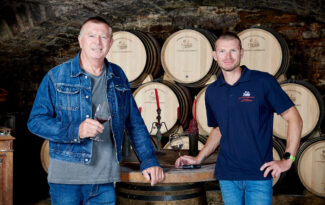
Jean-Michel and son Alexis Guillon, Domaine Jean-Michel Guillon & Fils
He says, “Our goal is to produce succulent wines that retain a clear sense of style and grace while remaining identifiably Pinot Noir. This can only be attained by attention to detail in the vineyard with yields kept low to produce the best fruit, and scrupulous vinification methods using 100% of the finest new oak. This is an approach we carry across the entire range of our wines, including the Marsannay.”
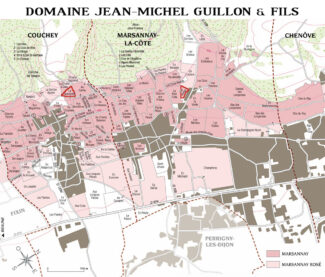
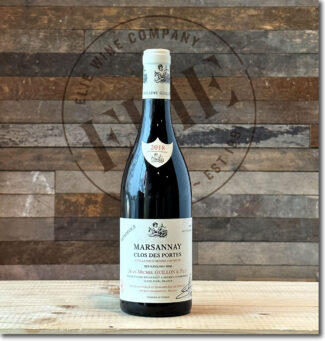 Domaine Jean-Michel Guillon & Fils, 2018 Marsannay ‘Clos des Portes’ Monopole ($64)
Domaine Jean-Michel Guillon & Fils, 2018 Marsannay ‘Clos des Portes’ Monopole ($64)
Jean Michel purchased the entire Clos des Portes lieu-dit in 2005, making it a monopole. Farmed at yields similar to his Grand Crus, it’s said to resemble Gevrey Chambertin before a Marsannay. Either way, it is a delicious and concentrated wine with lovely black raspberry fruit, spice, garrigue and fine nuances of raspberry pulp, lime and hints of hibiscus and jasmine.
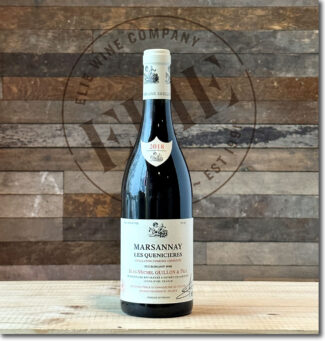 Domaine Jean-Michel Guillon & Fils, 2018 Marsannay ‘Les Quenicières’ ($61)
Domaine Jean-Michel Guillon & Fils, 2018 Marsannay ‘Les Quenicières’ ($61)
A discreet application of wood serves as a backdrop for the pretty plum, violet, earth and slightly gamy aromas; there is a mild touch of austerity to a balanced and refreshing finish. 1,200 bottles made.
Domaine Charles Audoin
Nobody knows the terroir of Marsannay quite like the Audoins. Having worked the soil and sold to négociants for multiple generations, 1972 heralded the year when the domain started bottling its own product. Under the management of Charles Audoin, the Audoin name on the label coincided with the expansion of the holdings from 6 acres to nearly 35.
Charles’s son Cyril took the reins in 2009, but Charles still remains active in the day to day operations, particularly in the vineyards. Cyril chose to keep the domain under his father’s name, as he credits his father with bringing the most change and attention to the property.
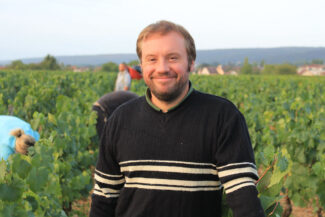
Cyril Audoin, Domaine Charles Audoin
Says Cyril, “Farming at the domain falls under the sustainable lutte raisonnée method, and we farm almost exclusively with organic practices. I have chosen to farm with the environment in mind, and all harvesting is done by hand with selective sorting done at several stages. Our wines are made in a very traditional manner—reds see a varying degree of whole cluster inclusion during ferments, though rarely more than 30%, and in some years, there is no stem inclusion at all. This is dependent on the vintage and ripeness of the fruit and stems. Extractions are on the lighter side, keeping with our focus on allowing the fruit to show the elegance and grace of our terroir. Élevage for all wines is carried out in barrel, mostly neutral but with varying degrees of new oak depending on the cuvée.”
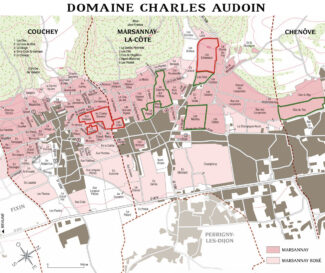
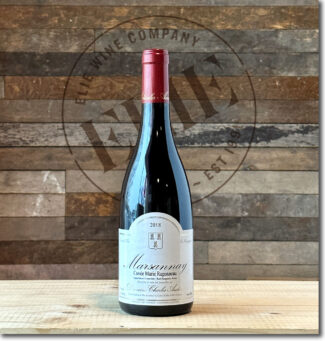 Domaine Charles Audoin ‘Cuvée Marie Ragonneau’, 2018 Marsannay ($48)
Domaine Charles Audoin ‘Cuvée Marie Ragonneau’, 2018 Marsannay ($48)
Named after Cyril’s great-grandmother, the blend originates from several top Audoin old vine parcels—Champs-Salomon, Les Crais, La Pucine, Herbues and Les Echezots. It’s intended as a representation of the village rather than a single vineyard. Tart cherry, cranberry and raspberry weave through a taut mineral core with black pepper and earth notes emerging on a mineral-driven finish.
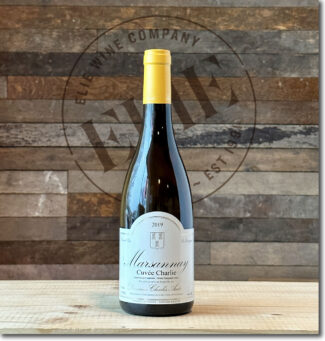 Domaine Charles Audoin ‘Cuvée Charlie’, 2019 Marsannay Blanc ($48)
Domaine Charles Audoin ‘Cuvée Charlie’, 2019 Marsannay Blanc ($48)
100% Chardonnay from Charme aux Prêtres and Clos du Roy, as well as a small portion of grapes from Les Récilles, Le Poiset and Les Crais. The bunches are 100% destemmed and cold macerated, and not crushed during pneumatic pressing in order to preserve the aroma and freshness. The wine then spends a year in 20% new oak barrels from the Vosges and is bottled unfined and unfiltered. The wine shows notes of honeysuckle and citrus while the oak provides a touch of toasted vanilla. The grapes are macerated for 15 days, then transferred to 20% new oak barrels to age for 12 to 18 months and six months in tanks, after which the wine is bottled without fining or filtration.
Vintage Journal
2020: Classical, Expressive with Outstanding Aging Potential
2020 produced Marsannay wines that are, in most descriptions, ‘classical’—a somewhat remarkable result since the season was also considered (in most descriptions) ‘extreme’. Few growers in the Côte de Nuit thought the hot and dry summer—in which many of them completed the entire harvest in August—could possibly produce such fresh and energetic wines. Despite the heat, the ‘crunchiness’ that results from balanced acidity remained quite prominent, and the concentration of the juice in smaller-than-average berries added a nice foil of richness. Among the top producers, tannins remained finely-grained and the wines are delightful in their youth, but capable of considerable improvement over time.
2018: Solar, Voluptuous with Immediate Appeal
In the Côte de Nuit, 2018 proved to be one of the rare vintages that offered both quality and quantity. On the face of it, the season was relatively straightforward; a wet winter and spring topped up the water reserves and the warm, sunny summer ensured the grapes reached ripeness without difficulty. The usual threats of disease, rot, frost and hail barely entered the picture, and harvest took place under blue skies with temperatures in the mid-eighties. That said, the exceptional heat and near-drought conditions posed a new challenge for vignerons—the need to pick early enough to preserve grapes’ acidity rather than the more familiar wait for phenolic ripeness. In the cellar, handling warm fruit with higher levels of sugar and lower acidity was another test for the region’s winemakers. The 2018 vintage has been referred to as both ‘une année de vigneron’ as well as ‘une année de vinificateur’.
- - -
Posted on 2023.04.07 in Côte de Nuits, Marsannay, France, Wine-Aid Packages | Read more...
André Clouet, One of Champagne’s Finest Practitioners of Pinotism, Crafts Pure Chardonnay ‘Dream’ in Pinot Noir’s Epicenter Grand Cru Bouzy + A Champagne Fairytale
The Clouet family is a family of winemakers whose origins are lost in the mists of time. What we can say for certain is that it was founded by a printer in the Versailles court of Louis XV and that the phrase that graces the winery’s labels (‘Ancien Regime’) is a tribute to this legacy. It took more than two centuries and several generations of Clouets to find and purchase land in the exquisite terroir of Bouzy in the southern part of the Mountain of Reims.
Under the mastery of Jean-François Clouet, André Clouet has modernized, but the team is inspired to preserve the personality of its Champagne as expressed through the personality of its terroir. Says Jean-François, “During Creation, when God grew weary of sculpting the mountains, razing the deserts and firing up the volcanoes, he treated himself to a few moments of pleasure and designed a little earthly paradise called Bouzy.”
Known for its sublime Pinot Noir-based Champagnes, among the most notable collections, the Dream Vintage Cuvées, are made entirely with Chardonnay and dedicated to the greatest recent vintages.
In addition, Coteaux Champenois from André Clouet reflects perhaps Champagne’s greatest secret: High quality still wine that rivals many from Burgundy.
Lastly, ‘Cuvée 1911’ is a brilliant multi-vintage Champagne made in commemoration of the year Jean-François Clouet’s great grandfather designed the bottles front label.
All are explored in this week’s many-tiered package.
The Landscape of Champagne
Having been defined and delimited by laws passed in 1927, the geography of Champagne is easily explained in a paragraph, but it may take one a lifetime to understand it.
Ninety-three miles east of Paris, Champagne’s production zone spreads across 319 villages and encompasses roughly 85,000 acres. 17 of those villages have a legal entitlement to Grand Cru ranking, while 42 may label their bottles ‘Premier Cru.’ Four main growing areas (Montagne de Reims, Vallée de la Marne, the Côte des Blancs and the Côte des Bar) encompass nearly 280,000 individual plots of vines, each measuring a little over one thousand square feet.
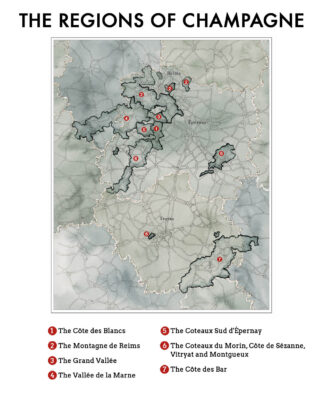
Beyond the overview lies a permutation of particulars; there are nearly as many micro-terroirs in Champagne as there are vineyard plots. Climate, subsoil and elevation are immutable; the talent, philosophies and techniques of the growers and producers are not. Ideally, every plot is worked according to its individual profile to establish a stamp of origin, creating unique wines that complement or contrast when final cuvées are created.
Champagne is predominantly made up of relatively flat countryside where cereal grain is the agricultural mainstay. Gently undulating hills are higher and more pronounced in the north, near the Ardennes, and in the south, an area known as the Plateau de Langres, and the most renowned vineyards lie on the chalky hills to the southwest of Reims and around the town of Epernay. Moderately steep terrain creates ideal vineyard sites by combining the superb drainage characteristic of chalky soils with excellent sun exposure, especially on south and east facing slopes.
Exploring Pinot Country: The Montagne de Reims
Whether based on tradition or technical savvy, the choice of the grape variety and rootstock best suited to a specific plot is an indispensable factor in determining the ultimate success of any lieu-dit, or named vineyard. Whereas most Champagne is a blend of Pinot Noir and Chardonnay, both grapes make unique demands on terroir, and where one may thrive, the other may not. Sandwiched between the Marne and the Vesle Rivers, forming a broad headland of forests and thickets, the Montagne de Reims is particularly suited to the former; Pinot Noir vines carpet the western and northern flanks to form a vast semicircle extend from Louvois to Villers-Allerand, encompassing the famous villages of Bouzy and Ambonnay.

Grand Crus Bouzy and Ambonnay: The Epicenter of Pinot Noir
Like Elizabeth I and Mary Queen of Scots, the Grand Crus of Bouzy and Ambonnay co-exist in begrudging mutual respect and rivalry, and unless one figures out how to sign the other’s death warrant, this will continue for the foreseeable future. At its closest point, the distance between the two communes is less than a long drive with a golf club, and each have shored up a reputation for superlative wines from the south side of the Montagne de Reims hill.
With a population just under one thousand, Bouzy is the best-known Champagne village to produce still wine (Bouzy Rouge) along with its legendary Pinot Noir-focused sparkling wine. More than nine hundred acres in Bouzy are under vine, with 87% of them Pinot Noir, 12% Chardonnay and a scant 0.2% Pinot Meunier. The most prominent Champagne houses with a Bouzy presence are Bollinger, Duval-Leroy, Moët & Chandon, Mumm, Pol Roger and Taittinger.
Nearby Ambonnay shares a nearly identical terroir with Bouzy on the south side of the Montagne de Reims hill, and is similarly appointed, although with slightly less Pinot Noir grown and a bit more Chardonnay—white grapes accounts for about 20% of the vineyards. Like Bouzy, ‘Ambonnay Rouge’ represents a small portion of wine production. Prominent Champagne houses that control Ambonnay vineyards include Duval Leroy, Moët & Chandon, Mumm, Piper Heidsieck, Pol Roger and Roederer.
Champagne André Clouet
The Privileged Custodian of Bouzy
Somewhat less prominent than the powerhouse producers mentioned above is grower-producer Jean-François Clouet of Champagne André Clouet, although Champagne Clouet has been around longer. The Clouet family traces its Bouzy roots to 1492 and at one time was the official printmakers for the court of King Louis XV; the classically pretty labels that grace their Champagne bottles today pay homage to their aesthetic history. Clouet grapes are sourced exclusively from 20 acres of coveted mid-slope vineyards in the Grand Cru villages of Bouzy and Ambonnay.
Says Jean-François Clouet, “The vineyards are like beautiful fabrics, each one contributing textures and colors that once assembled, are transformed into a designer gown. Successfully pieced together, it is Haute Couture.”

Born and raised in Bouzy, Jean-François still lives in his family’s 18th century home; with inimitable wit, he refers to himself as ‘a combination of winemaker and circus ringmaster.’ In fact, the French refer to him as ‘chef de cave’—a cellar master. He is arguably the region’s most qualified historian and insists that, without acknowledging the role that the past has played on his winemaking decisions, you can’t truly appreciate his wines.
“To understand Champagne as a whole you need to understand its political history,” he says. “Attila the Hun, the Crusaders, the Templars and Marie Antoinette have all walked here; the birth of the monarchy and the Battle of the Cathalunian Fields took place nearby. In 1911, my great grandfather designed the label that graces our bottles today; I like the idea of the work of human hands in pruning, performing the same actions as my grandfather and even the Romans, who planted vines here 2000 years ago.”
The ‘Dream’ Collection
Exploring Chardonnay: A Retrospective Spanning A Decade
Blanc de Blancs is a term found only in Champagne, and is used to refer to Champagne produced entirely from white grapes, most commonly Chardonnay. Pinot Blanc and Arbane can also be used, as well as a number of other varieties permitted in the appellation, but these are less common. In fact, André Clouet Dream Vintage Grand Cru is made entirely with Chardonnay from vineyards planted on clayey-calcareous soils.
Vintage Champagnes represent less than 5 percent of all Champagne production, typically produced only in select vintages. Vintage Champagne is aged for a minimum of three years in the bottle, as opposed to 15 months for non-vintage versions. “Aging is a luxury factor,” says James Beard Award-winning sommelier Belinda Chang: “There’s a lot of painstaking work and labor and real estate required to bring those gorgeous bottles of Champagne to us. Not only are they sourcing grapes from their best vintage, but the grapes are coming from highly venerated vineyards.”
Champagne André Clouet’s ‘Dream’ collection is a retrospective of Champagne’s top vintages over the past decade or so, each release labeled in a distinct color based on Cadillacs from the 1950s; Jean-François attempt to duplicate a ‘dream’ era for automotive elegance and power. A blend of the sharp, acidic Chardonnays of Mesnil-sur-Oger with the richer Chardonnays of Bouzy, the wines showcase the highest expression of Blanc de Blancs produced by the domain.
Harvesting is carried out manually, selecting the grapes in the vineyard. Once they arrive at the winery, and once they are pressed, the grapes ferment in small stainless-steel vats at a controlled temperature between 16ºC and 18ºC. Once the malolactic fermentation in these same vats has ended, the champagne aged in bottles for a minimum of 4 years with their lees, before the manual disgorgement.
 2004 Dream – Champagne André Clouet – Brut ($87)
2004 Dream – Champagne André Clouet – Brut ($87)
2004 was an extremely good vintage throughout Champagne; a cool spring warmed up in time to ensure a successful budburst and flowering. A sunny summer followed and conditions were so favorable that some producers had to green harvest to curb the overabundance of leaf growth. The previous year’s drought meant that water-tables within the soils were limited, subjecting the vines to slight water stress and concentrating the fruit—a good thing, in this case. Clouet’s 2004 offers a complex core of brioche, apples, citrus and chalky minerality. Disgorged February 2021.
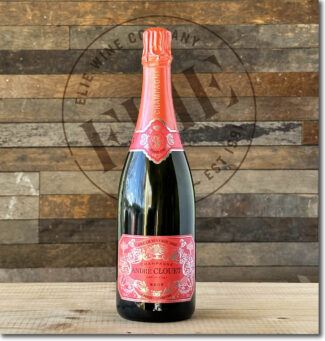 2005 Dream – Champagne André Clouet – Brut ($108)
2005 Dream – Champagne André Clouet – Brut ($108)
2005 was an excellent vintage, just short of outstanding. A dry winter and a bright spring allowed for a successful budburst and flowering, and good weather hung around until July, when persistent rains showers brought both humidity and mildew. Conditions marginally dried out in August, but temperatures were also cooler beyond the one significant heat spike that kick-started ripening. September delivered the warm, steady conditions needed to dry out the vines and push the surviving grapes to phenolic ripeness, while cool nights helped retain essential acidity and aromatics. 2005 ‘Dream’ shows layers of mineral-infused stone fruit on a silky, mid-weight frame, with gorgeous length and a refined, subtle mousse. Disgorged October 2021
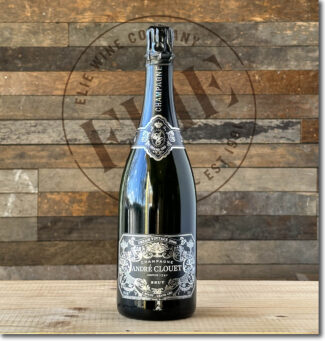 2006 Dream – Champagne André Clouet – Brut ($72)
2006 Dream – Champagne André Clouet – Brut ($72)
Overall, 2006 was average in Champagne, with good wines made only by circumspect vignerons. Flowering was excellent, but the growing season was defined by a markedly dry summer, with June and July delivering a series of searingly hot weeks and a premature ripening of berries. A significant mid-summer thunderstorm pelted various vineyards with hail, following which, the sunny streak did not return until early autumn. A gloomy August brought humidity inspiring rot, mildew and unwanted bouts of botrytis. Fortunately, September saw a return of warm, dry days which helped push the fruit to phenolic ripeness while cool nights were conducive to preserving essential acidity. 2006 Clouet offers wonderful bouquet of apples and poached pear along with buttered brioche and palate rich in salty minerals and a touch of hazelnut praline. Disgorged July 2021.
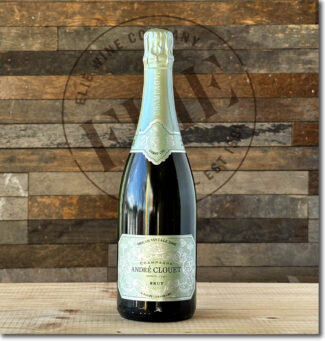 2008 Dream – Champagne André Clouet – Brut ($87)
2008 Dream – Champagne André Clouet – Brut ($87)
In Champagne, the 2008 vintage was sublime, especially in Bouzy. To earn such distinction, cooler summer weather is almost a requirement—for grapes to reach phenolic ripeness sufficient to harvest, it helps is the process is slow and steady. The only downside of 2008 was the global recession which drove prices downward and effected every aspect of Champagne production. Although the region was hit hard by economics, the 2008 vintage is considered nearly legendary for quality. Clouet’s 2008 expresses the pedigree of the vintage: Complex and nuanced, it boasts dried pear, mint, chamomile, crushed rock, dried flowers and pastry overtones laced together over an acidic core. Disgorged October 2021.
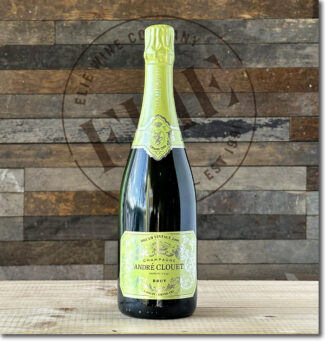 2009 Dream – Champagne André Clouet – Brut ($62)
2009 Dream – Champagne André Clouet – Brut ($62)
2009 was a fabulous vintage in Champagne; a dry winter left the water table low, but spring rains quickly topped them off. Vicious storms popped up in July, hitting Aÿ fairly hard, but Bouzy came through virtually unscathed. August brought warmth and sunshine and enough dry heat to prevent rot and mildew; nights remain cool, and acidity from this vintage may be pronounced. Clouet’s 2009 is a beautifully balanced package, with acids reined in by whirlwind of creamy aromas and caramelized apple, green pear, brioche, lemon-citrus peel on the palate. Disgorged July 2021.
 2013 Dream – Champagne André Clouet – Brut ($54)
2013 Dream – Champagne André Clouet – Brut ($54)
Chardonnay grapes were the clear champions in a very average growing season; 2013 suffered from a cold and wet lead-in winter and a spring in which budburst and flowering were delayed. Cooler than normal temperature subjected the vines to millerandage and coulure, cutting yields. Aube and Marne experienced tricky weather throughout much of the season and a July hailstorm further reduced the crop. Among the vintage Champagnes produced, Blanc de Blanc were the most notable, and Clouet’s 2013 is voluptuous and vibrant with lemon oil, lightly-toasted walnuts, crisp yellow apples, acacia honey and a racy, acidic finish. Disgorged October 2021.
The ‘Dream’ Collection Set
This six-bottle set is an excellent opportunity to sample the nuances of each of a half dozen notable growing seasons for Champagne André Clouet. A limited release of 36 sets were assembled by the producer specially for Elie Wine Co. ($470) Limited.

Still in Champagne: Introducing Coteaux Champenois
Covering the same territory as Champagne, Coteaux Champenois may be the wine world’s most celebrated oxymoron: Flat Champagne. By ‘flat’, of course, we are not talking about the week-old Andre in the back of the fridge or the after-effects of shaking a bottle of Cristal after winning the Grand Prix, but the intentional act of releasing a still wine from the same terroir that would otherwise undergo the extraordinary process used to create Champagne.
Spread across 319 communes, Coteaux Champenois producers are entitled to use seven varieties, alone or in tandem; seven grape varieties are sanctioned in the production of Coteaux Champenois, including the Champagne staples Chardonnay, Pinot Noir and Pinot Meunier along with Arbane, Petit Meslier and the Pinot derivatives, Pinot Blanc and Pinot Gris. In general, all these grapes thrive at region’s latitude (48 – 49° North) although like their sparkling counterparts, Coteaux Champenois wines tend to be dry and light-bodied with naturally high acidity. The reds are much better in the warmer vintages of recent years, as the predominant variety, Pinot Noir, is able to ripen more consistently.
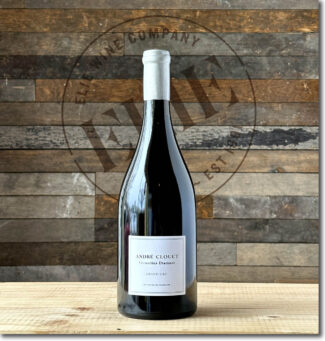 André Clouet ‘Versailles Diamant’, 2015 Coteaux Champenois Grand Cru Blanc ($108)
André Clouet ‘Versailles Diamant’, 2015 Coteaux Champenois Grand Cru Blanc ($108)
Tyson Stelzer (Wine Spectator, Decanter, Vinous) refers to Diamant as ‘the best Coteaux Champenois I have tasted to date.’ Sourced from the Grand Cru vineyards of Bouzy and Ambonnay, the 100% Chardonnay wine spends 20 months in Vicard barrels. Beautifully textured, the wine shows green apple, lemon, tropical fruit, pineapple, dried flowers with a persistent lemon and lime finish.
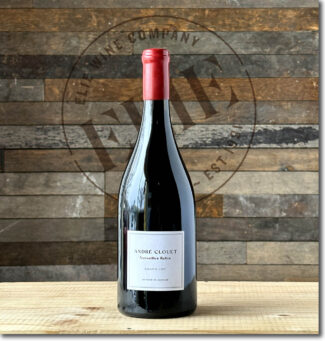 André Clouet ‘Versailles Rubis’, 2015 Coteaux Champenois Grand Cru Rouge ($108)
André Clouet ‘Versailles Rubis’, 2015 Coteaux Champenois Grand Cru Rouge ($108)
Produced from pure Pinot Noir sourced from Grand Cru vineyards in the heart of the Montagne de Reims, the varieties undisputed home. Like the Blanc, the Rouge is aged for 20 months in Vicard barrels—one of the finest coopers in the region. The wine shows tart cherry behind silky tannins a clear and pronounced minerality on the palate.
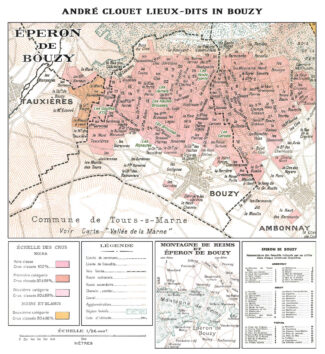
‘One Day in 1911 … ’ A Champagne Fairytale
Commemorating the year Jean-François Clouet’s great grandfather designed the bottles front label, ‘Un Jour de 1911…’ is the domain’s tête de cuvée, with production limited to 1,911 bottles per disgorgement. Made from 100% Pinot Noir sourced from the Clouet’s ten best lieux-dits in the Grand Cru vineyards of Bouzy, the wine has been aged for six years on the lees—a remarkable span for a non-vintage Champagne.
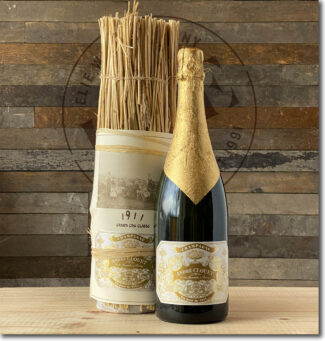 Champagne André Clouet ‘Un Jour de 1911…’ Grand Cru Bouzy, Brut ($90)
Champagne André Clouet ‘Un Jour de 1911…’ Grand Cru Bouzy, Brut ($90)
At dosage of 0.5 g/l, 50% of the wine was fermented in stainless steel tanks and 50% in Sauternes barrels. 50% perpetual reserve with an assemblage that also includes four vintages: all of which are made from Grand Cru Bouzy estate-grown fruit.
Dosage 0.5 g, 50% 2008 vintages fermented in barrels and It is delicately perfumed with sweet rose petal and jasmine and framed in austere minerality and balanced autolytic notes. Despite the relatively recent disgorgement, the mousse presents itself as extraordinarily elegant. Disgorged August 2022.
- - -
Posted on 2023.03.30 in France, Champagne | Read more...
What Land Really Smells Like: Two Passionate Grower-Makers Capture New Catalunya’s Mediterranean Fauna & Flora, Natural·ly (6-Bottle Pack $175)
‘Streaks of independence, evolving practices, a respect for nature and for those who coddle it.’ … It’s hard to find better examples of these traits than in the wilds of New Catalunya, where a younger generation has delved deeply into the remarkable earth of sea-and-sun-kissed Penedès.
Among the best, natural winemakers Pepe Raventós and Francesc Escala and the husband/wife team Raimon Badell and Anna have rewritten some of the oldest rules while emblazoning new ones, becoming templates for a wine-making renaissance that has wowed us at Elie’s for many years. These two iconic, iconoclastic wine houses have managed to bottle personality, honesty and knowledge, as this week’s 6-Bottle Pack ($175) should make obvious.
The New Catalunya
To a wine novice, France may seem to be a bottomless morass of rules and regulations, appellations and multi-syllabic, hyphenated names.
Spain suffers from the opposite misinterpretation: It is often oversimplified.
When the conversation turns to Spanish wine, many people are lost after the word Rioja is mentioned. They may have a surface familiarity with Cava based primarily on price, but may not be aware that Freixenet (the top-selling brand) is even Spanish.
The truth is, heavy, overly-oaked Riojas and inexpensive Cava have long been efficiently sellable standards that animated the American market, and even Spanish consumers may not be familiar with the spectacular array of styles and varieties that make their nation every bit the equal of the world’s other wine producing countries.
Not only that, but Spain produces more wine than any other country after Italy.
The Spanish wine renaissance of recent decades may be playing out best in Catalunya—the ‘land of castles’—a fascinating autonomous community in the northeast corner of the Iberian Peninsula. For many years, like much of Europe, young people moved away from an agricultural life in pursuit of cosmopolitan prospects.

Recently, however, the flight has reversed course and young people intent on creating artisan wines are finding new opportunities in an ancient culture. They are moving away from the trend-driven varieties that gained a foothold during the 1990s (Merlot, Cabernet and Syrah) and many are focused on an array of local grapes like Xarel·lo, Macabeu, Garnatxa Blanca and Parellada along with indigenous reds like Garnatxa, Monastrell and Trepat. Styles are also moving away from heavy wood-soaked Rioja and toward freshness, acidity and finer structure. And a growing number of smaller Spanish producers have rejected industrial farming in favor of organic and biodynamic practices in hopes of a sustainable future where this time, their own children may decide to stick around.
Returning to Roots: Indigenous Grapes
Ironically, most Americans are very familiar with French grape varieties even though they rarely appear on French wine labels. California is largely responsible for this phenomenon, an appellation that in its youth was less sold on terroir and more on identifying and exploiting popular flavors. That has changed, of course, but variety almost always figures prominently on California labels, even those that also tout a given patch of land.
Following this trend as a means of increasing market share, Spain tore out many thousands of acres of indigenous grapes in favor of flavor-of-the-month. Graced by an ideal climate under which many these varieties thrived, a move back to the roots (literally) of winemaking has prompted the revival of those grapes that grew in Spain initially. To a neophyte, these names may look like the typist had his finger on the wrong row of keys, but each of them—Tinta del Pais, Ull de Llebre, Cencibel, Pedro Ximénez et al.—have their own unique profile and create wines unparalleled elsewhere in the world.
Reaching Back into The Past: Méthode Ancestrale
Méthode Ancestrale is worthy of its name; it is the oldest known method of producing sparkling wine. It is also known as ‘rurale, gaillacoise, artisanale, pétillant naturel’ and in some appellations, ‘pétillant originel’, but in brief, it is a technique that involves bottling wine partway through its primary fermentation to trap carbon dioxide gas in the bottle, creating a gentle, bubbly carbonation.
It is similar to, but not identical to the Méthode Champenoise used in Champagne and, by law, for Cava. Ancestral method wines go through a single fermentation and are bottled before the fermentation process is completed, producing a wine with low alcohol gentle carbonation, and muted sweetness; they are generally unfiltered. Champenoise method wines go through a second fermentation in the bottle, which raises its alcohol content and creates its signature bubbles.
The Gesture of Natural: Wine in The Raw
In wine, ‘natural’ is a concept before it’s a style. It refers to a philosophy; an attitude. It may involve a regimen of rituals or it may be as simple as a gesture, but the goal, in nearly every case, is the purest expression of terroir that a winemaker, working within a given vineyard, can fashion. Not all natural wines are created equal, and some are clearly better than others, but of course, neither is every estate the same, nor every soil type, nor each individual vigneron’s ideology.
The theory is sound: To reveal the most honest nuances in a grape’s nature, especially when reared in a specific environment, the less intervention used, the better. If flaws arise in the final product—off-flavors, rogue, or ‘stuck’ fermentation (when natures takes its course), it may often be laid at the door of inexperience. Natural wine purists often claim that this technique is ancient and that making without preservatives is the historical precedent. That’s not entirely true, of course; using sulfites to kill bacteria or errant yeast strains dates to the 8th century BCE. What is fact, however, is that some ‘natural’ wines are wonderful and others are not, and that the most successful arise from an overall organoleptic perspective may be better called ‘low-intervention’ wine, or ‘raw’ wine—terminology now adopted by many vignerons and sommeliers.
At its most dogmatic and (arguably) most OCD, natural wines come from vineyards not sprayed with pesticides or herbicides, where the grapes are picked by hand and fermented with native years; they are fined via gravity and use no additives to preserve or shore up flavor, including sugar and sulfites. Winemakers who prefer to eliminate the very real risk of contaminating an entire harvest may use small amounts of sulfites to preserve and stabilize (10 to 35 parts per million) and in natural wine circles, this is generally considered an acceptable amount, especially if the estate maintains a biodynamic approach to vineyard management.
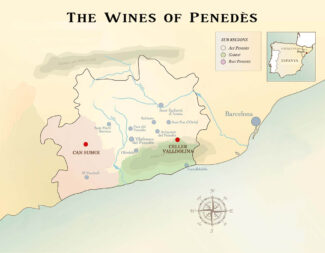
Can Sumoi
Meet Pepe Raventós and Francesc Escala: A pair of childhood buddies who are living the dream—their own dream, of course, in the backwoods of Catalunya. Having found Can Sumoi (an agricultural farm dating to 1645) in the mountains of the Baix Penedès where they realized their vision and dreams in the remarkable landscape and passion for natural wines.
They purchased the property from an ailing farmer, Josep Mateu, whom they have allowed to live on in the farmhouse where he was born. Having grown up in a culture where hard work was a condition of survival, Mateu is able to appreciate the vigor of the young men to whom the torch has been passed.
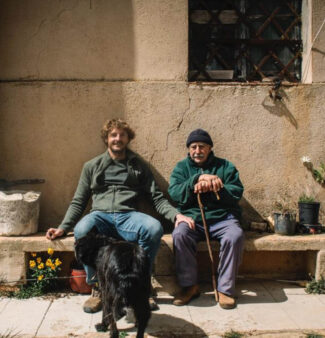
Pepe Raventós, Can Sumoi, and Josep Mateu
The estate sprawls across a thousand acres, of which fewer than fifty are vineyards, planted to Parellada, Xarel-lo and Sumoll. Reaching elevations of nearly two thousand feet, orientation of the vines depends on variety; Parellada, for example, prefers eastern and western exposures. The sea, which can be seen in the east, has left its influence, and the terroir is filled with marine fossils that are over a million years old. So clear is the atmosphere at this elevation that, on days without wind, you can see Mallorca and the Ebro Delta.
Almost 800 acres of the farm is woodland, and as Josep Mateu looks back at his life, he says, “Now that the forest has been gaining ground from the vineyard, between the trunks of the holm oaks you can see the white pines and tall oak trees, the old dry stone walls we built many years ago to facilitate the cultivation of the vines in terraces.”
This return to nature is the cornerstone of Pepe Raventós’ approach to vine cultivation and the natural wines of Raventós i Blanc. He says, “I’m not a great specialist in biodynamics, but I observe the countryside and I see how it responds. If we apply its methodology and in a few years I see that the earth is more alive, more balanced and we are getting better wines, I continue to apply it …of course.”
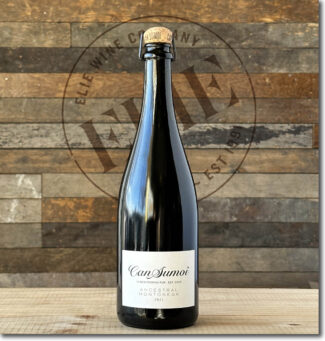 Can Sumoi ‘Ancestral Montònega’, 2021 Catalunya Escumòs Mètode Ancestral Brut Nature ‘Natural’ ($27) (sparkling)
Can Sumoi ‘Ancestral Montònega’, 2021 Catalunya Escumòs Mètode Ancestral Brut Nature ‘Natural’ ($27) (sparkling)
‘Montònega’ is a local name for Parellada, and this sparkling wine is made entirely from this native variety. Hand harvested, destemmed and softly pressed in the winery, the fermentation process begins in stainless steel tanks and finishes in the bottle. Only indigenous yeast is employed; the must spends 14 days inert and 16 days in the bottle; no sugar is added and the wine is neither stabilized nor filtered. Natural SO2 is 13mg/l Aged in bottle for 4 months before release and shows crisp, focused minerality with citrus, apple and herbal notes, especially rosemary.
 Can Sumoi ‘Xarel·lo’, 2020 Penedès ‘Natural’ ($27) (white)
Can Sumoi ‘Xarel·lo’, 2020 Penedès ‘Natural’ ($27) (white)
A striking still-wine example of this unusual variety, generally used in sparkling wine, from vineyards located at 1800 feet on clay-calcareous soils. After the manual harvest, the grapes are destemmed and gently pressed in an inert atmosphere. Fermentation is carried out in stainless steel on yeasts native to the vineyard. Once the alcoholic fermentation has ended, the wine goes through the malolactic fermentation spontaneously, then rests on lees for 3 months, with bâtonnage twice a week. It is bottled without stabilizing or filtering and shows Xarel·lo’s characteristic peach, crisp green apple and toasted almond notes.
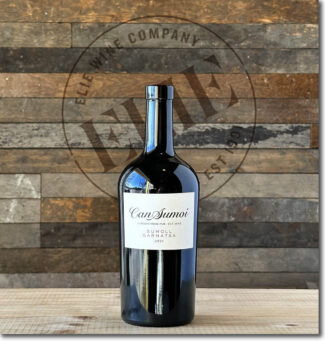 Can Sumoi ‘Sumoll Garnatxa’, 2021 Penedès ‘Natural’ ($27) (red)
Can Sumoi ‘Sumoll Garnatxa’, 2021 Penedès ‘Natural’ ($27) (red)
Grenache by any other name would smell as sweet, and when blended with Sumoll, it offers an intense nose of wild fruits and Mediterranean forest herbs. Made from an equal combination of Sumoll and Grenache, Can Sumoi’s ‘Sumoll Garnatxa’ first sorts grapes harvested from biodynamic vineyards filled with rocky, clay and limestone soils sitting at 2000 feet elevation, one of Penedès’ highest points. The grapes were harvested during September, destemmed and hand (or rather, foot) pressed in an inert atmosphere, then spontaneously fermented in stainless steel tanks for 15 days, then kept in the tanks for a full year, after which it was bottled and aged for a further 6 months without added sulfites before hitting the market. It is light and elegant with the crisp acidity inherent in mountain wines.
Uvala (Celler VallDolina)
Based at Can Tutusaus, in the center of the remote village of Olesa de Bonesvalls in the Garraf Natural Park, VallDolina has become a pet project of husband Raimon Badell and wife Anna, whose award-winning Cava is proudly featured on the shelves here at Elie’s. As a team, Raimon and Anna have replanted ancient terraces in a rocky landscape otherwise dominated by pine trees interspersed with glimpses of the Mediterranean sea. The oldest vines at VallDolina were planted by Raimon’s father during a last-century’s craze for international grape varieties, and the Merlot remains an outstanding Spanish example of this variety.
The estate and its surrounding pine groves has stood since 1348, but it was only in 1729 that the country house was rebuilt within the village of Olesa, where the cellar is presently situated. The property comprises several acres of olive groves—resuscitated after years of neglect—and about thirty acres of vines. The rest is a maze of pine and oak forests, dwarf shrubs, brooms, fennel, rosemary, thyme, lavender and dwarf palms.
In 1987, seduced by this mysterious land, Joan Badell bottled his first wines and planted his first trained vines. In 1999, his son Raimon, who was then studying oenology, became a close collaborator and opted to turn the estate toward ecological and biodynamical agriculture. In 2006, oenologist Ferran Gil García joined the VallDolina Viticulturists and Winemakers of Can Tutusaus project, and began tending the vineyards. Their joint efforts has made possible the production of a white wine, a rosé, three outstanding reds and three different types of Cava.
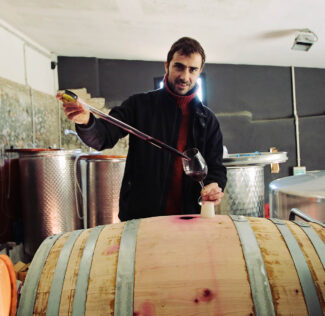
Raimon Badell, Celler VallDolina
“We only work with grapes picked from this estate,” says Rai, “where vines are situated between 800 and 1500 feet above sea level, bordering the Natural Park of the Massif of Garraf. The vineyards grow on hills with calcareous-clay soil and produce where the climate is distinctly Mediterranean, strongly influenced by the vicinity of the sea.”
 Celler VallDolina ‘Uvala Ancestral – Xarel·lo’, 2021 Catalunya Escumòs Mètode Ancestral ‘Natural’ ($25) (sparkling)
Celler VallDolina ‘Uvala Ancestral – Xarel·lo’, 2021 Catalunya Escumòs Mètode Ancestral ‘Natural’ ($25) (sparkling)
Gold in a bottle; from the pale yellow hue with gilded tones to the wealth of aromas that evolve and expand with golden tones. The creamy nuances behind the purity of white fruit is the result of native yeasts while the unctuous mouth and salty undertones are the product of the terroir.
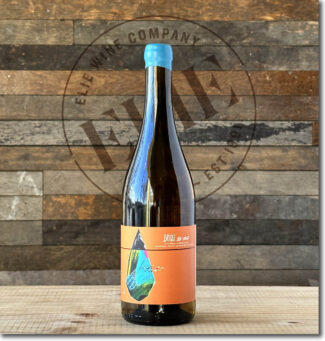 Celler VallDolina ‘Uvala Brisat – Xarel·lo’, 2021 Catalunya ‘Natural’ ($35) (orange)
Celler VallDolina ‘Uvala Brisat – Xarel·lo’, 2021 Catalunya ‘Natural’ ($35) (orange)
‘Brisa’ is a Catalan word meaning ‘pomace’ and ‘Brisat’ refers to the prolonged skin contact this wine underwent through the fermentation process. The wine shows straw yellow with pink highlights; the aroma is gorgeous, filled with citrus, peach, flowers and herbs that follow through the delicate fruity mouth and a pleasant tannins in a long finish.
 Celler VallDolina ‘Uvalal – Marselan’, 2019 Catalunya ‘Natural’ ($34) (red)
Celler VallDolina ‘Uvalal – Marselan’, 2019 Catalunya ‘Natural’ ($34) (red)
Marselan is a red wine grape that is a cross between Cabernet Sauvignon and Grenache, first bred in 1961 by Paul Truel near the French town of Marseillan. The first Spanish Marselan grapes were planted in 1990 and have made a little headway in Catalunya. VallDolina’s version is softly kissed with aromas of bramble fruits (raspberry and blackberry), cassis and ripe cherry accompanied by spicy notes of cinnamon and clove.
- - -
Posted on 2023.03.28 in Penedes, Spain DO, Wine-Aid Packages | Read more...
Haute Couture Viticulture: The Lasting Power Of Domaine de Courcel’s Great Pommards Evidenced in Collection Spanning a Quarter Century
Haute couture is the ultimate expression of French style, whether it is made manifest in clothing, art or wine. The word ‘couture’ may, in this instance, apply to anything handmade, but to add the qualifier ‘haute’, the requirements are more stringent.
About 95% of Pommard vineyards are owned by families, but only about half of them actually produce and label their own wines. Among them, Domaine de Courcel leads the pack, proving the difference between making wine and making haute couture wine.

Pommard is a fine occasion for which to rise; many past examples from various producers are markedly rustic and may require years before they shed their tough skin—at which point, much of the fruit may have vanished. Under the leadership of Gilles de Courcel (with his sisters, Anne Bommelaer and Marie de Courcel) and the stewardship of winemaker Yves Confuron, Domaine de Courcel has striven for low yields (generally picked late in the season), fermented in whole-bunch cluster and aged a bit longer in oak before bottling. This is, perhaps, the key technical approach that has made de Courcel a leader in haute couture wine for more than four hundred years.
“Too often winemakers make a style, not a wine,” says Gilles de Courcel, “which is what many négociants do when they blend wines they buy from different estates.”
With vintage selections drawn from 1996 all the way to the recently released 2019s, a quarter century of de Courcel excellence should be evidence of the haute couture viticulture embraced this ancient and revered domain.
POMMARD
Night in Combat With Day
Victor Hugo famous description of Pommard as ‘night in combat with the day’ is as poetic a summation of the appellation’s dichotomy as can be found. Located within the Côte de Beaune (home to some of the world’s most celebrated white wines) Pommard produces exclusively red wine, and bottles an iconic Pinot Noir with both muscle and lyrical complexity.
With vineyards situated between 700 and 1100 feet, terroir varies by location. On the lower ground, the soil is composed of ancient alluvium, while mid-slope, clay-limestone soils are well drained, due primarily to rock debris. Higher still are Jurassic (Oxfordian) marls, brown calcic soils and brown limestone soils. In places, these soils are reddened by the presence of iron, a factor in the power, density and even ‘blood’ notes that Pommard may bring to a bottle.
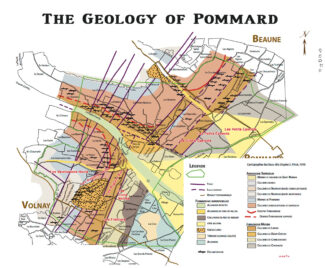
Among the fuller-bodied wines of Burgundy, none benefit more from bottle aging than Pommard. In its youth, its aromas, redolent of blackberry and gooseberry, cherry and ripe plum, are hedonistic and delicious, but with time, intriguing changes take place. At full maturity, flavors metamorphose towards leather, chocolate and pepper. Even young, Pommard should be allowed a period of time in glass or decanter to ‘open up’ as aeration smooths aggressive tannins and allows fruit flavors to blossom.
DOMAINE DE COURCEL
For the past four hundred years, the de Courcel family has produced award-winning Pommard wines from some of the region’s most renowned vineyards. Its reputation is all the more remarkable, considering that the domain never produces more than 30,000 bottles per year.
Essentially built around Premier Cru sites, de Courcel’s 26 acres are peppered across Le Grand Clos des Épenots, Les Rugiens, Les Frémiers and Les Croix Noires. Le Grand Clos des Épenots, which accounts for 50% of the Domaine’s production, and Les Rugiens are in a climat class of their own. The estate is currently managed by Gilles de Courcel, Anne Bommelaer and Marie de Courcel.
Marie is justifiably proud both of her family’s place in Burgundian history and the estate’s commitment to terroir and ecology: “We plough in such a way as to encourage intense biological activity, enabling the vines to better assimilate the minerals contained within the soil. The ploughing also helps the root of the vine penetrate deeper into the ground for a better expression. We optimize ripeness by pruning techniques, including de-budding and green harvesting in early August. We are after a delicate equilibrium in the fruit, and our final harvest is done relatively late so that the September sunshine increases the sugar intensity.”
This commitment carries through to the cellar, where, according to Gilles de Courcel, “Wine making is done over a period of one month following a very thorough selection of grapes. Cold maceration followed by low-temperature fermentation to enable better extraction. Delicate reassembly in the wine vat is done to enhance the color and the tannins, and the process ends with a final post-fermentation carbonic maceration adapted to each cuvée.”
The maturing of the wine is then done in carefully selected oak barrels, replaced by a third each year. After racking (‘sous-tirage’), the wines are bottled without any treatment or manipulation.
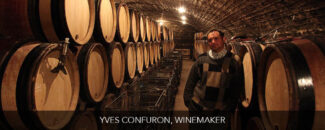
Yves Confuron, de Courcel’s winemaker has always worked organically, believing that anything else would not be true to the expression of the site. Far from being a nod to the current fashion of biodynamics, it is an understanding each site must be treated naturally and maintained immaculately in order to wrest everything that it has to offer in a given vintage. He argues. “You cannot do this by picking anything but fruit as ripe as the vintage can make it, and that the whole bunches must go into the vat because that is all part of the origin.”
Also the owner (with his brother Jean-Pierre Confuron) and winemaker at the prestigious Domaine Confuron-Cotetidot in Vosne Romanée, Yves balances his time delicately between the two domains, creating a house style whose pricing rarely reflects the care that goes into them.
Regional Burgundy
Les Bourgogne 2019
So specific are the cru vineyards of Burgundy that régionale vineyards may exist in the literal shadow of more renowned domains, occasionally separated by hundreds, or even as little as dozens of feet. Régionale wines tend to be culled from vineyards located along the foot of more prestigious wine-growing slopes on limestone soil mixed with some clays and marls, where the earth is stony and quick-draining.
Unlike Bordeaux, where classifications are based on individual châteaux (capable of buying other vineyards and expanding), Burgundian label classifications are more geographically focused. A single vineyard, therefore, may have multiple owners, each with a small piece of the action.
The ‘Bourgogne’ label first appeared in 1937, and in 2017, a further classification permitted wines from vineyards located within the Côte d’Or to be labeled as ‘Bourgogne Côte d’Or’; it’s a great tool for a consumer looking to explore the wide diversity of vineyard among the Hills of Gold while maintaining a terroir-focused, climat approach to Burgundy.
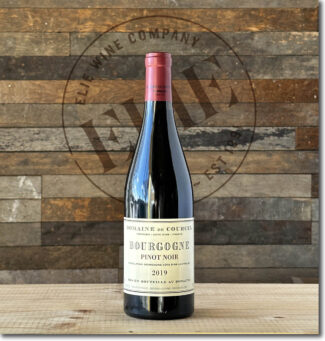 2019 Domaine de Courcel, Bourgogne Rouge ‘Pinot Noir’ ($79)
2019 Domaine de Courcel, Bourgogne Rouge ‘Pinot Noir’ ($79)
The wine originates in a lower vineyard adjacent to Pommard where vines average 40 years and the brown soil has built up at the bottom of the slope on flatter grounds. The same careful consideration is taken with de Courcel’s regional wines as with their Premier Crus, including low-temperature fermentation to enable better extraction. The wine is bold and bright with a slightly meaty edge to its forward berry and sweet spices.
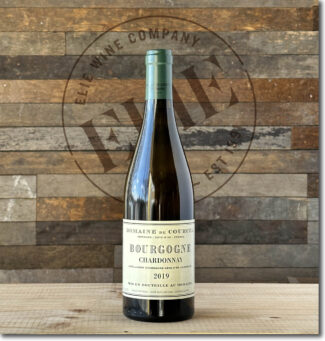 2019 Domaine de Courcel, Bourgogne Blanc ‘Chardonnay’ ($58)
2019 Domaine de Courcel, Bourgogne Blanc ‘Chardonnay’ ($58)
From vines around 20 years old, treated with the same care as the estate’s Premier Crus. Butterscotch, honey and citrus flavors dominate this wine, with a stony minerality that underscores the tertiary aromatics just beginning to emerge.

THE FOUR PREMIER CRUS
As mentioned, Domaine de Courcel produces wine from four outstanding Premier Cru vineyards—Le Grand Clos des Épenots, Les Rugiens, Les Frémiers and Les Croix Noires. Taken one by one, the differences and the similarities may be evidence to the marvelous terroir of Pommard:
Premier Cru
Le Grand Clos des Épenots
Le Grand Clos des Épenots is an enclosed monopole, meaning that de Courcel owns the entire plot, 3 acres in Le Grand Clos des Épenots and nine more in Les Petits Épenots. The land is located north of Pommard, at the start of the slope and is east-facing. The top soil, which is rich in clay and limestone, is brown and strewn with limestone rocks and is depth of the soil is around two feet deep, and its structure acts as a natural filter. The vines are 60 years old and produce wines with aromas of red berries and ripe white fruits often associated with Chardonnay—peaches or apricots—although it is planted entirely to Pinot Noir.
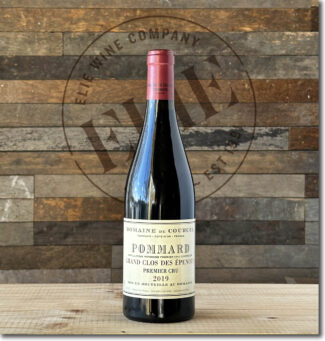 2019 Domaine de Courcel, Pommard Premier Cru Grand Clos des Épenots ($193)
2019 Domaine de Courcel, Pommard Premier Cru Grand Clos des Épenots ($193)
Sumptuous and debonair, the black-cherry aroma shows notes of licorice and cinnamon that ripple beautifully to the edges and re-emerge on a long finish.
 2016 Domaine de Courcel, Pommard Premier Cru Grand Clos des Épenots ($210)
2016 Domaine de Courcel, Pommard Premier Cru Grand Clos des Épenots ($210)
A mature wine that retains a ripe nose and displays notes of cassis, black cherry, spice and a touch of wood smoke.
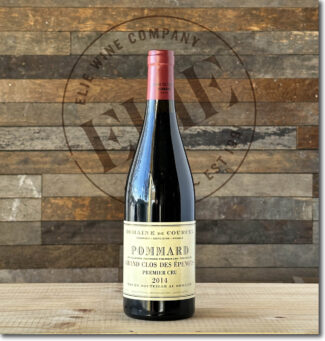 2014 Domaine de Courcel, Pommard Premier Cru Grand Clos des Épenots ($180)
2014 Domaine de Courcel, Pommard Premier Cru Grand Clos des Épenots ($180)
Épenots was hit hard by hail in 2014, losing a substantial portion of the crop. That which remained is lovely with a fresh nose followed by hints of coffee and caramel.
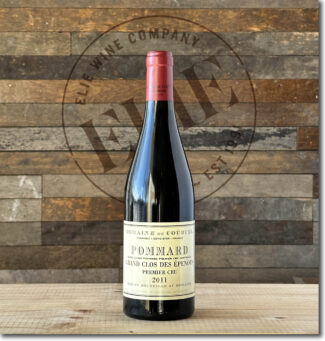 2011 Domaine de Courcel, Pommard Premier Cru Grand Clos des Épenots ($180)
2011 Domaine de Courcel, Pommard Premier Cru Grand Clos des Épenots ($180)
Elegant age with the intensity of youth; the nose shows wild mushroom, forest floor, plum, and sandalwood, while the palate has evolved to dried red cherry and citrus oil extract. It’s bone dry and beautifully acidic.
 2009 Domaine de Courcel, Pommard Premier Cru Grand Clos des Épenots ($230)
2009 Domaine de Courcel, Pommard Premier Cru Grand Clos des Épenots ($230)
Picked late in the harvest and allowed to ferment 100% whole-cluster. The wine is massively earthy with spice and rich, ripe tannins. A wine which will benefit immeasurably with aeration before drinking.
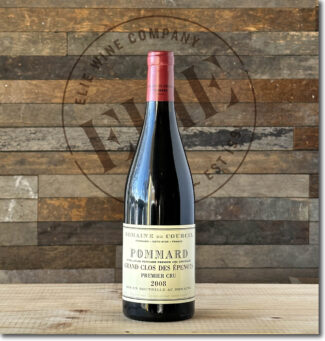 2008 Domaine de Courcel, Pommard Premier Cru Grand Clos des Epenots ($180)
2008 Domaine de Courcel, Pommard Premier Cru Grand Clos des Epenots ($180)
A wine that will highly reward a 90-minute decant to allow the acidity to recede in favor of depth and roundness with a core of dried strawberries, white pepper and the savory sous-bois that is characteristic of Pommard’s ruggedness.
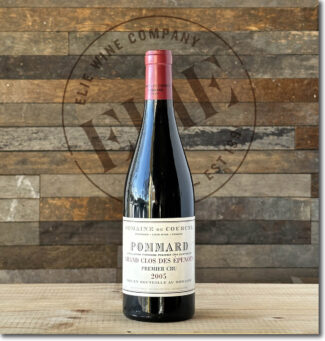 2005 Domaine de Courcel, Pommard Premier Cru Grand Clos des Épenots ($250)
2005 Domaine de Courcel, Pommard Premier Cru Grand Clos des Épenots ($250)
Red berries remain dominant in this unparalleled Pommard, with mint, earth, fig, red licorice all very present. Well integrated and really quite ready to drink now but could also age another 15 years under proper conditions.
Premier Cru
Les Rugiens
Domaine de Courcel’s 3-acre Les Rugiens plot is planted on marlstone and iron-rich clay slopes with eastern exposures. As with the domaine’s Le Grand Clos des Épenots site, these Pinot Noir vines are, on average, 60 years old. Rugiens is one of Pommard’s most highly prized vineyards and, with the Épenots sites, is considered by many to be worthy of Grand Cru status. Rugiens wines are generally full-bodied and brooding in character, with smoky, spicy aromas and are usually capable of aging for many years. It is divided into two parcels bisected by a country lane; Les Rugiens Bas and Les Rugiens Hauts. As in Épenots, wines blended from these two climats may be called Rugiens, but as Les Rugiens Bas is often considered the better of the two, it is often identified on labels.
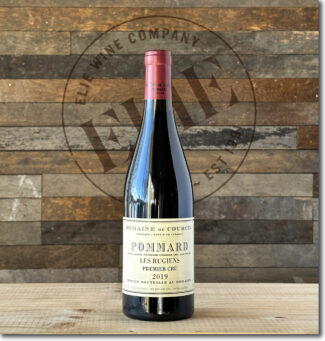 2019 Domaine de Courcel, Pommard Premier Cru Les Rugiens ($255)
2019 Domaine de Courcel, Pommard Premier Cru Les Rugiens ($255)
Fine spicy in an airy nose with rich tannins and concentrated fruit, predominately forest berries.
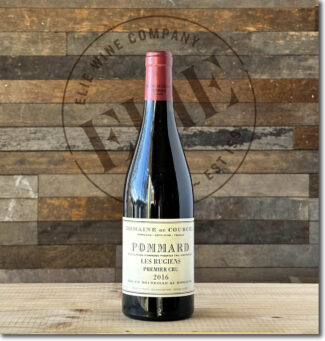 2016 Domaine de Courcel, Pommard Premier Cru Les Rugiens ($280)
2016 Domaine de Courcel, Pommard Premier Cru Les Rugiens ($280)
A vibrant nose that combines blackberry, boysenberry, kirsch, violet, minerals and chocolate. The palate adds smoky blackberries, cassis, cloves and cinnamon in a densely saturated wine with an ample chassis of rich, chewy tannins.
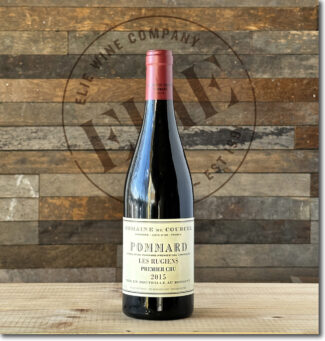 2015 Domaine de Courcel, Pommard Premier Cru Les Rugiens ($320)
2015 Domaine de Courcel, Pommard Premier Cru Les Rugiens ($320)
Effusive black cherry, cassis and violet enshrouded with a backbone of assertive, dusty tannins. All the elements are in the correct proportion and have begun to fully integrate.
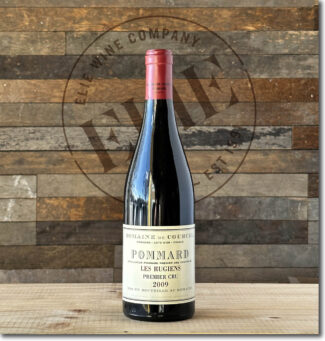 2009 Domaine de Courcel, Pommard Premier Cru Les Rugiens ($350)
2009 Domaine de Courcel, Pommard Premier Cru Les Rugiens ($350)
A truly great Rugiens, massively concentrated, ripe and sumptuously opulent with a subtle minerality that lifts the tannins. It is creamy and rich with a finish that highlights graphite and should continue to improve for another half a century.
Premier Cru
Les Frémiers
‘Les Frémiers’ is a four-acre climat, formerly the property of the Maizière Abbey. The vineyard owes its name to the word ‘fremyer’, which meant ‘firm’ or ‘robust’ in Old French. Adjacent to the ‘Les Fremiets’ vineyard in Volnay, the wines share the same elegance and maturity. Located south of Pommard, right below Les Rugiens at the start of the slope, the brown soil, which is rich with both clay and limestone, is deeper than at Rugiens. The aromas here lean towards fine spices and dried fruit, and the tannins tend to be refined.
 2019 Domaine de Courcel, Pommard Premier Cru Les Frémiers ($149)
2019 Domaine de Courcel, Pommard Premier Cru Les Frémiers ($149)
A highly expressive nose redolent of rose hips and tangy red berries, dried herbs, hibiscus and cranberry with smoke and truffle nuances and acidic flair.
 2009 Domaine de Courcel, Pommard Premier Cru Les Frémiers ($220)
2009 Domaine de Courcel, Pommard Premier Cru Les Frémiers ($220)
Intensely perfumed with aromas of autumn berries, sweet and savory spice, oak and a touch of sous bois with iron in a mineral driven finish.
 1996 Domaine de Courcel, Pommard Premier Cru Les Frémiers ($220)
1996 Domaine de Courcel, Pommard Premier Cru Les Frémiers ($220)
A perfectly mature Pommard that emits aromas of muddled strawberry, black raspberry and cranberry along with aged saddle leather, forest floor, truffle, white pepper, dried herbs and tar with a finished of crushed rock.
Premier Cru
Les Croix Noires
Les Croix Noires, meaning ‘the black crosses,’ is a small lieu-dit (3.2 acres) located just to the south of Pommard village, in the center of the Pommard appellation. It sits on very gentle east facing slopes about halfway down the band of Premier Cru vineyards and is, in fact, surrounded by them. Les Chaponnières lies on the slope above it and to the west is Les Poutures, with Les Bertins below, and to the east and southeast and Les Frémiers to the south. Domaine de Courcel owns around half of the small vineyard.
 2019 Domaine de Courcel, Pommard Premier Cru Les Croix Noires ($149)
2019 Domaine de Courcel, Pommard Premier Cru Les Croix Noires ($149)
Ripe and rich with a sweet lift above the concentrated fruit with hints of menthol, violet and spice adding breadth to the opulent texture.
LE POMMARD VILLAGE
Pommard is the first major town you come to as you travel south from Beaune and it covers almost 800 acres of vines that radiate from the village center, enough to produce nearly two million bottles per year. 544 acres are rated ‘Villages’ level and about 300 acres are Premier Cru—an extraordinary amount.
Villages—the quality level below Premier Cru—is the most affordable path to understanding the underlying ‘sense of place’ that is the Holy Grail of Burgundian wine ideology. Many of the qualities that are assigned to various Crus are recognizable at this level, if in a slightly dilute form—Savigny’s meatiness, Volnay’s elegance, Vosne-Romanée’s spice and Meursault’s buttery nuttiness. Legal restrictions help to underscore this: Villages wines have a slightly higher yield allowances per hectare, but the grape varieties are restricted. Not only that, but even Grand Cru vineyard owners can declassify grapes when they see fit, and many of these end up in Villages-level wines.
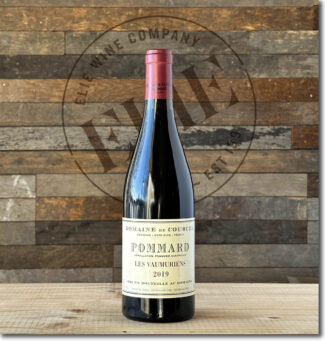 2019 Domaine de Courcel, Pommard ‘Les Vaumuriens’ ($132)
2019 Domaine de Courcel, Pommard ‘Les Vaumuriens’ ($132)
The wine exhibits all the classical flavors typically associated with Pommard like dark fruit notes with earthy undertones. Black cherry, blackberry and violets dominate the nose, while mushroom and fresh potting soil round out a lengthy finish. This is a very age-worthy wine, capable of being cellared for a minimum of 10 more years.
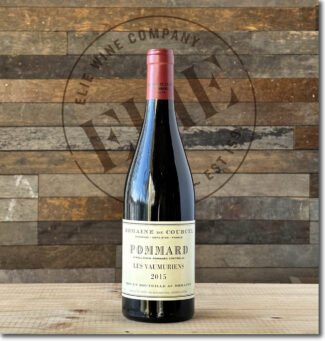 2015 Domaine de Courcel, Pommard ‘Les Vaumuriens’ ($130)
2015 Domaine de Courcel, Pommard ‘Les Vaumuriens’ ($130)
Only 100 cases were imported of this excellent vintage 45-year-old vines on the left slope of Pommard. Their north-north-east aspect helped retain cool freshness in the otherwise-ripe vintage and the flavors have settled.
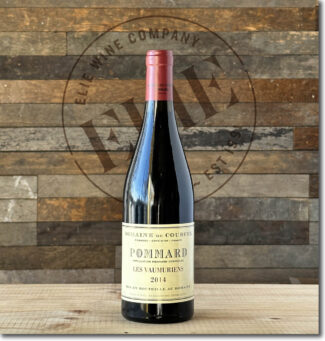 2014 Domaine de Courcel, Pommard ‘Les Vaumuriens’ ($180)
2014 Domaine de Courcel, Pommard ‘Les Vaumuriens’ ($180)
Restrained aromas of raspberry and earth dominate the bouquet. In a very dry style but fine-grained in the middle palate, showing good texture for the year. The tannins, rougher in the first few years, but have now integrated to allow the wine to express a bit of finishing sweetness.
Vintage Journal
2019 Vintage: The Magic of Years Ending With ‘9’ Actually Worked
Since the start of the 20th century, every vintage that has ended with a “9” has been wonderful. The only downside to 2019 was below-average volumes, but otherwise, it was a thrilling year for Pinot Noir in particular, which delivered wines bursting with perfume and succulent fruit. Jacques-Frédéric Mugnier—who crafted some of 2019’s most compelling wines—remarked the ‘19s were “Supple and enveloping, simultaneously serious and immensely charming. I have never before encountered a vintage that tasted so good, so young.”
2016 Vintage: A Pleasant Surprise
An extremely mild winter gave way to a cooler than average March, although conditions eventually warmed up enough to allow for a typically-timed budburst. Alas, a tempestuous spring followed with harrowing frosts where the worst-hit vineyards were those at high altitude as the sun hammered into the frozen vines, adding literal burns to the already severe frost damage. Overall, the harvest was modest and for some producers, the smallest one on record. But the grapes that survived the frosts were generally of exceptionally high quality, and in top estates, Burgundy 2016 is a classic vintage renowned for its balance and poise. The reds, in particular, are rich, ripe and balanced.
2015 Vintage: Simply Sublime!
For the most part, the 2015 vintage was one of remarkable harmony between nature and wine cellars; temperatures were dry, skies sunny, and when rain fell, it was sporadic and needed. Flowering took place in early June, followed by véraison in mid-July, with the start of harvesting happening at the end of August. Weather dictated the tempo, and winemakers had to adapt to a sustained pace. Those who stepped up laid the foundation of a great vintage.
2014 Vintage: All The Makings of A Great Vintage
2014 got off to a good start; the spring was warm and dry, leading to a fairly early bud break and an uneventful flowering in early June. Problems began later in the month with a hailstorm that tore through Pommard and caused considerable damage with some estates reporting losses that averaged about half their usual crop. The harvest was smaller than usual, but the quality was high, with the reds in particular showing classic character—refined and concentrated without being overbearing, and a freshness ideal for early drinking, while the best examples have enough character and structure to warrant long-term cellaring.
2011 Vintage: Pleasure is The Watchword
2011 proved to be a tricky and challenging vintage for growers, but experience prevailed and the wines turned out well, with the reds in particular aromatic and fresh with considerable purity of fruit. The early summer was cool, but in late June temperatures soared, and the heat spike caused sunburn on exposed bunches. July was cooler than April, and hail on July 12 smashed into the southern Côte de Beaune. In late July the weather improved and it stayed warm into August, but storms persisted sporadically. Much depended on the health of the grapes and on the strength of the skins and thus their resistance to disease, and since this varies from site to site, grape sorting was essential.
2009 Vintage: Magnificent Bourgogne!
Initial vintage comparisons made with 2005 and even 1990 were a trifle optimistic, but the wines have proven to be beautifully ripe and fleshy and of a surprisingly uniform quality throughout the Côte de Beaune. Spring was hot and dry and flowering was early, beginning in late May. Stormy spells in mid-July threatened mildew, but warm weather soon returned and most of August was hot, allowing the fruit to ripen perfectly, especially since early September continued warm. In Pommard, a little September rain was timely and welcome and growers who picked at the optimum time have been rewarded with superb wines.
2008 Vintage: A Lovely Turnaround
2008 was largely good throughout Burgundy with a damp and somewhat chilly spring delaying budburst, but the weather cleared and remained warm. Pommard suffered a vicious hailstorm in late July that reduced the crop, but September brought settled sunny weather and cool winds that whipped round the vineyards and dried the vines. The sunny days also pushed the grapes towards phenolic ripeness, while cool nights helped retain essential acidity through an idyllic harvest. The best examples of Pommard show bright, concentrated fruit with balanced acidity, gentle tannins and a distinct spiciness.
2005 Vintage: An Exceptional Year
It’s no secret that 2005 was legendary throughout Burgundy, and the wines of Pommard happily went along for the ride and became a top-producing appellation. A warm, easy spring saw both an early budburst and flowering and led to a dry, sunny June and July. In August, temperatures dipped a bit and September saw some sporadic relieving showers, which helped rehydrate the vines. The late warm weather also served to slowly usher the grapes to phenolic ripeness. These superb conditions allowed for an easy and relaxed harvest where almost without exception, grapes were thick-skinned and in exceptionally good health.
1996 Vintage: Long Lived
A fine vintage characterized by fresh acidity, leading to long-lived wines. Very warm weather in June led to a swift flowering, but the summer was a bit unsettled and August was relatively cool. But by late August and through September, sunny and dry conditions prevailed in Pommard, with cool nights that conserved the balance in the grapes. The outcome was a large crop of extremely healthy grapes, with high sugars, excellent acidity and deep colors.
- - -
Posted on 2023.03.16 in Côte de Beaune, Pommard, France, Burgundy | Read more...
Domaine Pierre Usseglio is on a Sensational Roll in Châteauneuf-du-Pape and Lirac + In-Store, Walk-Around Tasting With Grégory Usseglio
As a display of gratitude to those who have taken advantage of the many wine packages we have offered in the past, we invite you to an in-store experience, free of charge, to discover (and re-discover) one of our favorite Châteauneuf-du-Pape producers, Domaine Pierre Usseglio & Fils. It will also be an opportunity to purchase the wines at prices deeply discounted for the evening only.
Grégory Usseglio, grandson of the estate’s founder, will be on hand as host of a walk-around tasting on March 16, between 5PM and 7PM. We will feature wines from some of Usseglio’s most spectacular vintages of the past decade, and Gregory will share the winery’s unique vision; innovation steeped in tradition with a commitment to making Usseglio wines accessible to a wide range of palates.
Please call for an update on details and to reserve. Limited. (248) 398-0030
Meet Grégory Usseglio
There are many Usseglios to keep track of, although perhaps the correct Italian plural of the surname is ‘Ussegli’. Pierre Usseglio (of the eponymous Domaine) is not to be confused with his brother Raymond Usseglio, owner of a different winery. Domaine Pierre Usseglio was founded in 1948 by Francis Usseglio, who moved to Southern Rhône from Italy in 1931, and Pierre Usseglio’s children Jean-Pierre Usseglio and Thierry Usseglio have managed the Pierre Usseglio estate since 1999.
Now that you have them straight, we will introduce Grégory Usseglio, Jean-Pierre`s son, who becomes more involved in the domain with every vintage.
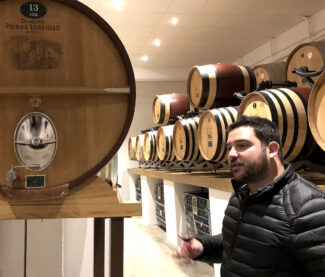
Grégory Usseglio
“One thing that has not changed,” says Grégory, “is our philosophy of tradition blended with innovation. In the late 1980s we began to isolate a small number of vines to make ‘Mon Aïeul’ and subsequently, to make a barrel selection, including some new oak, to make a prestige cuvée. There are other experiments going on, including some non-commercial cuvées. But really, heritage rules the roost here; all of our wines are pure and not dramatic or overdone. We remain true to the terroir of the commune, with vines planted throughout Châteauneuf. We enjoy the power of the south, while maintaining a light and elegant touch in the cellar.”
Domaine Pierre Usseglio & Fils
The quintessence of Châteauneuf-du-Pape is the conviction that the sum of parts is greater than the whole. As such, Domaine Pierre Usseglio maintains 60 acres of vines spread out across the entire region, maintaining property in 17 individual lieux-dits with one plot set aside for the production of white wine. The red-wine holdings are planted to 80% Grenache, 10% Syrah, 5% Mourvèdre, 5% Cinsault; vine age ranges from 30 to 75 years of age. A sizeable portion of the CdP vineyard sits within famous La Crau ancient confluence of the Durance and Rhône rivers; the rest climbs the hill across the road from the actual ruins of the castle from which Châteauneuf-du-Pape gets its name.

The estate also owns 15 acres of Côtes-du-Rhône, another 15 in Lirac and another five acres that it bottles as ‘Vin de France.’
Says Jean-Pierre: “We work our vineyard manually, and with respect throughout the seasons. We let nature express itself freely. It is thanks to this difference in terroir that we can offer complex, silky and balanced wines; our vines are spread across multiple sites where the soils range from limestone and rolled pebbles, to sand and sandstone flecked with clay. These are the voices of the earth and we are committed to listening.”
Châteauneuf-du-Pape
A Peak Expression of The Southern Rhône
Châteauneuf-du-Pape in France’s Rhône valley has traditionally been viewed as a rustic cousin to the elegant and long-lived persistence of great wines from Bordeaux. Châteauneuf is age-worthy, certainly, but there is exuberance in the fresh fruit flavors that dominate the style that makes it hedonistically drinkable virtually from the day it is released. It was said to make up for in pleasure what it lacked in sophistication.
With more than 8,000 acres under vine, Châteauneuf-du-Pape is the largest appellation in the Rhône, producing only two wines, red Châteauneuf-du-Pape, representing 94% of the appellation’s output, and white Châteauneuf-du-Pape. Of the eight red varietals planted, Grenache is the most dominant variety by far, taking up 80% of vineyard space, followed by Syrah, Mourvèdre and tiny quantities of Cinsault, Muscardin, Counoise, Vaccarèse and Terret Noir.
Terroir varies and can only be viewed as a generalization; limestone soil predominates in the western part of Châteauneuf-du-Pape; sand and clay soil covered with large stones on the plateaus. Mixed sand, red and grey clay, and limestone can be found in the northern part of the appellation, less stony soil alternating with marl in the east and shallow sand and clay soil on a well-drained layer of gravel in the south. The large pebbles contribute to the quality of the vines and grapes by storing heat during the day and holding water.

Untrained Old Vines Grenache Bush in Galets Roulés

Grès Rouge, Sand and Safre
Like the soils, there is an enormous diversity of winemaking styles among these producers, creating both appealing, easy-to-understand fruit-filled wines as well as wines of greater intensity and sophistication.
A new generation of CdP is making wines that rival the depth of the best Bordeaux, offering a wide array of compelling aromatics, including Herbes de Provence, black cherry jam, black currants, blueberries, blackberries, roasted meats and even beef blood. These wines can be powerful, rich, full-bodied and concentrated enough to evolve for 15 to 25 years.
* Of the grapes that make up Usseglio’s Châteauneuf-du-Pape, Gregory Usseglio shares the following: “The Grenache comes from clay-rich soils in the Crau district; the Syrah comes from Cabrières; the Mourvèdre comes from a sandy lieu-dit called Valori just to the north of the appellation and the Cinsault and Clairette come from various plots composed of rolled pebbles, clay and sand. Grapes are harvested and selected manually with yields as low as 20-25hl/ha according to vintage conditions, mostly destemmed then fermented separately, and the wine is aged 12 months, half in oak foudre and half in concrete tank.”
 Domaine Pierre Usseglio & Fils ‘Cuvée Tradition’, 2019 Châteauneuf-du-Pape ($55)
Domaine Pierre Usseglio & Fils ‘Cuvée Tradition’, 2019 Châteauneuf-du-Pape ($55)
Primarily Grenache, with 15% each of Syrah and Mourvèdre and 10% Cinsault, showing cinnamon, strawberry and cocoa on the nose with a luscious palate filled with cassis, cherry compote and red licorice.
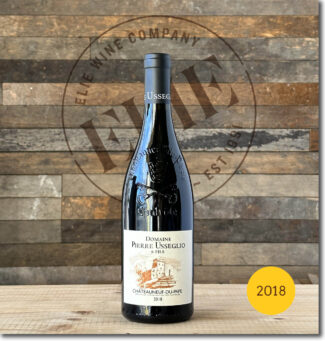 Domaine Pierre Usseglio & Fils ‘Cuvée Tradition’, 2018 Châteauneuf-du-Pape ($55)
Domaine Pierre Usseglio & Fils ‘Cuvée Tradition’, 2018 Châteauneuf-du-Pape ($55)
A classic Usseglio cuvée based on 55% Grenache, 25% Syrah, 15% Mourvèdre and the balance Cinsault, fermented primarily in concrete tanks. Loaded with dark cherries, plum and peppery spices that enlivens a fleshy palate. Produced from tiny yields of approximately 15 hectoliters per hectare, it should drink well for at least a decade.
Cuvée de Mon Aïeul
Usseglio’s flagship wine produced from highly selective plots that narrow lieux-dits down still further. Only Grenache vines between 75 and 90 years old are used, originating from La Crau, Bédines and Serres. No destemming is done and fermentation lasts for 30-40 days.
Having made its debut in 1998, and translating to ‘My Grandfather’, Mon Aïeul has been made from 100% Grenache since 2020; previously, 5% Syrah was used in the blend. Half of each year’s blend wine is aged for 12 months in used demi-muids while the remained is aged in concrete tanks. Production averages 650 cases per year.
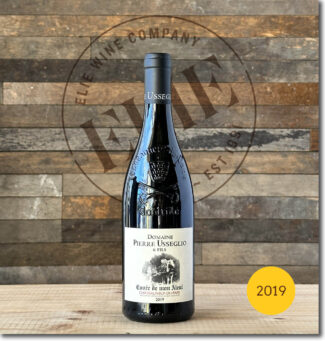 Domaine Pierre Usseglio & Fils ‘Cuvée de Mon Aïeul’, 2019 Châteauneuf-du-Pape ($126)
Domaine Pierre Usseglio & Fils ‘Cuvée de Mon Aïeul’, 2019 Châteauneuf-du-Pape ($126)
Full-bodied, lusciously textured and round, showing upfront notes of Asian spice, cocoa, and mint with a palate loaded with blackberry, kirsch and raspberry behind a granite-shale minerality.
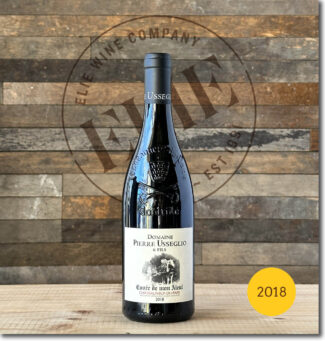 Domaine Pierre Usseglio & Fils ‘Cuvée de Mon Aïeul’, 2018 Châteauneuf-du-Pape ($126)
Domaine Pierre Usseglio & Fils ‘Cuvée de Mon Aïeul’, 2018 Châteauneuf-du-Pape ($126)
All whole-cluster Grenache aged in used demi-muids; the wine displays waves of ripe raspberries and black cherries drizzled with dark chocolate and spice. As usual, this cuvée comes from older vines in the La Crau, La Guigasse, and Les Serres lieux-dits, which are a mix of more pebbly and sandy soils. It ratchets up the intensity over the classic cuvée yet stays beautifully balanced with weightless texture, a great mid-palate, and a blockbuster of a finish.
 Domaine Pierre Usseglio & Fils ‘Cuvée de Mon Aïeul’, 2016 Châteauneuf-du-Pape ($126)
Domaine Pierre Usseglio & Fils ‘Cuvée de Mon Aïeul’, 2016 Châteauneuf-du-Pape ($126)
From one of the best growing seasons in recent history; the savory, mature flavors are just beginning to shine through. The years have added weight and gravitas to the wine; it shows voluptuous black fig and boysenberry preserves while retaining elegance and freshness with black and red fruit flavors intensely concentrated.
Réserve des 2 Frères
Domaine Pierre Usseglio Réserve des Deux Frères made its debut with the 2000 vintage. The name was changed to ‘Réserve des 2 Frères’ in 2007 along with a label redesign.
The wine is made from the estate’s oldest Grenache vines. Previously made with 10% Syrah, this only rarely the case today, although a small percent of Syrah went into vintage 2020. Grapes are usually completely destemmed; the level of stem retention depends on the vintage.
Slightly more modern in style than the tradition-heavy ‘grandfather’ wine ‘Mon Aïeul, ‘Two Brothers’ is aged in a combination of 10% new demi-muids and 10% new oak barrels along with a combination of one- or two-year-old French oak barrels, where it ages for 12-20 months. Domaine Pierre Usseglio Reserve des 2 Frères is not made every year, and when it is, only 500 cases are produced.
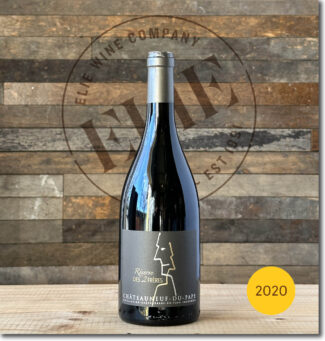 Domaine Pierre Usseglio & Fils ‘Réserve des 2 Frères’, 2020 Châteauneuf-du-Pape ($180) Pre-order
Domaine Pierre Usseglio & Fils ‘Réserve des 2 Frères’, 2020 Châteauneuf-du-Pape ($180) Pre-order
A splash of Syrah in the 2020 bottling leads to a fresh and focused wine, balanced, toasty and loaded with raspberry liqueur, crème de cassis, graphite, smoke meats, licorice that combines power and elegance.
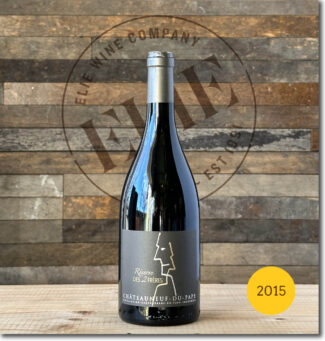 Domaine Pierre Usseglio & Fils ‘Réserve des 2 Frères’, 2015 Châteauneuf-du-Pape ($207)
Domaine Pierre Usseglio & Fils ‘Réserve des 2 Frères’, 2015 Châteauneuf-du-Pape ($207)
Grenache (per se) is not always the best candidate for aging; it possesses a naturally low concentration of phenolics, which contribute to its pale color and lack of extract. With a propensity for oxidation, Grenache-based wines tend to be made for early consumption.
But in Châteauneuf-du-Pape, under the hands of skillful viticulture and planted in marginal soil with restricted yields, all that changes. The vibrant fruit of young Grenache mellows and spice box tones come out with leather, and in this wine, tar, black olives and tobacco.
Châteauneuf-du-Pape Blanc
White Châteauneuf seems both an oxymoron and a paradox—not only does the warm Mediterranean climate of Southern Rhône seem far more suited to blustery reds, the grapes that make up the region’s white counterpart (Grenache Blanc, Roussanne, Bourboulenc and Clairette and to a lesser extent, Clairette Rosé, Grenache Gris, Picardin, Picpoul Blanc and Picpoul Gris) are not notably aromatic or high in acid. Yet, by preventing secondary malolactic fermentation, the acids are retained and the scents and synergy of the final wine exemplifies Provençal gardens, displaying heady floral notes with crisp, juicy peach and apricot.
Not only that, but they are often more consistent in quality than the reds and can reward long cellaring with remarkable results.
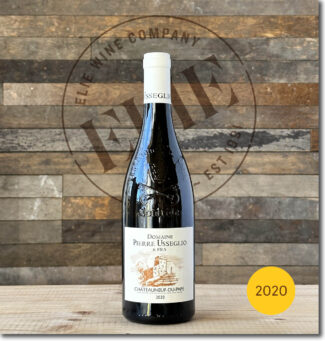 Domaine Pierre Usseglio & Fils, 2020 Châteauneuf-du-Pape Blanc ($67)
Domaine Pierre Usseglio & Fils, 2020 Châteauneuf-du-Pape Blanc ($67)
2.5 Acres is used in the production. A blend of 70% Clairette, 25% Grenache Blanc and 5% Bourboulenc, fermented and matured in a mix of vessels including stainless steel, barrels and amphorae. Fragrant and youthful with a wonderful salinity below flavors of white peach, pears and apples with some pronounced flintiness; the wine has excellent grip and bold extract with multiple layers that continue through a long finish.
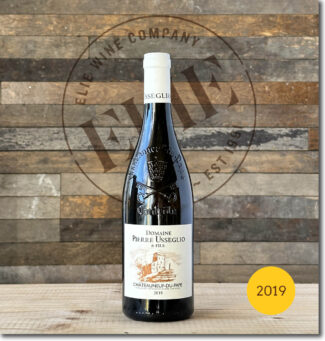 Domaine Pierre Usseglio & Fils, 2019 Châteauneuf-du-Pape Blanc ($55)
Domaine Pierre Usseglio & Fils, 2019 Châteauneuf-du-Pape Blanc ($55)
Usseglio’s 2019 Châteauneuf-du-Pape Blanc is a blend of 70% Clairette, 25% Grenache Blanc and 5% Bourboulenc, most of which was fermented and matured in stainless steel. Twenty percent barrel-fermentation adds just a touch of honeyed richness to the pineapple and tangerine flavors in this full-bodied effort; crushed citrus peel, salty minerality and hints of white peach emerges en route to a long, silky finish.
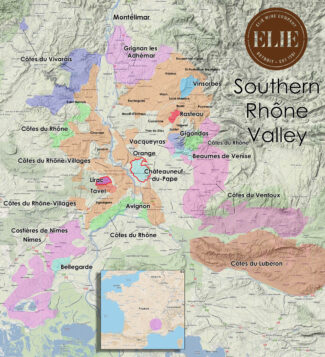
Lirac
A Short Hop Across The River From Châteauneuf-du-Pape
On the western side of the Rhône River, about six miles north of Avignon, Lirac is a typically Mediterranean wine growing cru, with low yearly rainfall and high sunshine levels (especially during summer and into the harvest months). The famous Mistral wind from the north plays a significant cooling role, and blows, on average, 180 days a year.
Lirac terroir is largely built around elevation; vineyards on the upper terraces of the appellation are made up of red clay and the large pebbles known as ‘terrasses villafranchiennes’, with the soil of the lower vineyards gradually showing more loess and/or clay-limestone. All are prone to summer drought and, under certain strictures, irrigation is allowed.
“The terroir of Lirac is often hidden in the shadows of Châteauneuf-du-Pape,” says Laure Poisson of Les Vignerons de Tavel & Lirac. “But in recent years, Lirac has emerged from the shadows to become something different, something unique.”
Blend makeup in Lirac wines is reasonably focused, with regulations favoring the classic Grenache, Syrah, Mourvèdre (and a bit of Cinsault) blend. Grenache must make up a minimum of 40% of the blend while Syrah and Mourvedre must be over or equal to 25%.
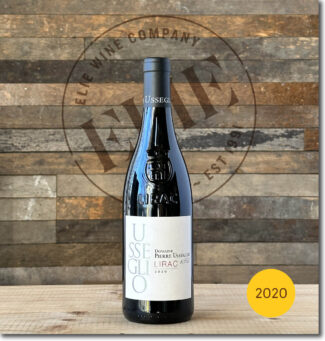 Domaine Pierre Usseglio & Fils, 2020 Lirac ($33)
Domaine Pierre Usseglio & Fils, 2020 Lirac ($33)
Usseglio & Fils’ 2020 Lirac is produced with 50% Grenache, 25% Mourvèdre, 20% Syrah from vines averaging 40 years old. A sweet core of blackberry is enshrouded in notes of black plum, black currant, aniseed and traces of new leather which lend promise to a cellar-worthy gem.
Famille Pierre Usseglio
L’Unique
Greater Than The Sum of Its Parts
The purpose of inventing the ‘Vin de France’ appellation was purely commercial; for a country whose wines are so inextricably linked to place of origin, a category that allows grapes from anywhere in the country to be used may seem like an odd innovation. But, faced with competition from elsewhere, it allowed winemakers to create a lower-priced product that could compete with New World wines. And, as is the case in a nation of vignerons, VdF wines are (for the most part) of self-evident quality, with many approachable, easy-to-understand prizewinners.
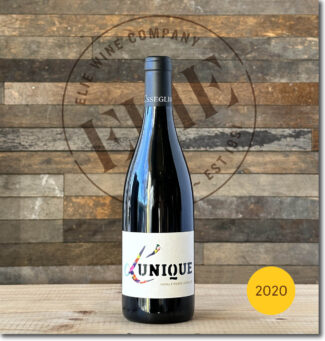 Famille Pierre Usseglio ‘L’Unique’, (2020) Vin de France ($25)
Famille Pierre Usseglio ‘L’Unique’, (2020) Vin de France ($25)
The spirit of VdF is loud and clear from the playful label on this blend of Grenache (40%), Syrah (20%), Mourvèdre (20%), Marselan (15%) and Merlot (5%) macerated for 25 days followed by six months aging in concrete before release. The wine is ripe and fruit-forward with fresh red berries, spring flowers and light spices. Very much an everyday wine that proves the Usseglio clan’s deft hand with all strata of winemaking, even in the level playing field that VdF encourages.
Vintage Journal
2020 Châteauneuf-du-Pape
Following the extreme heat of 2019, growers were hoping for plenty of rainfall over the winter to replenish aquafers, and they got it. An astonishing 15 -20 inches of rain fell between October and December, and a mild early spring saw vine buds break nearly two weeks earlier than in 2019. The summer was hot, but not unreasonably so; rains were moderate and frequent enough to prevent heat stress. Harvest for white grapes began in the third week of August, and the 2020 vintage is extremely strong in this category, however small (only 5% of Châteauneuf-du-Pape’s total). It is characterized by elegance and beauty, with a nose marked by citrus and stone fruit and a palate that combines balanced acidity with a prolonged finish.
2019 Châteauneuf-du-Pape
Grenache, however, enjoyed a marvelous renaissance in 2019, and for this sun, heat and wind-loving variety, the vintage was ideal. An abundant fruit set was followed by three heat waves interspersed with rain and more moderate temperatures, and as a result, there was no stress for the vines and ripening never shut down. Growers were able to pick at optimum ripeness and nothing much had to be done in the vineyard. The fruit’s health carried through to the cellar, with many growers reporting that their vinification were fast and efficient.
2018 Châteauneuf-du-Pape
The quintessence of a year that the old winemaker’s cliché refers to ‘a vintage made in the vineyard’—based on the difficulty that growers had bringing in the harvest. Rains in May and June created a poor fruit set for Grenache, and the threat of mildew was redoubled by the failure of the mistral; a rare occurrence in Châteauneuf-du-Pape. Humidity skyrocketed, making 2018 the dampest year since 1973, and organic farmers grew frustrated that natural treatments were washed away by un-forecasted rain. The result was a harvest that in particular showed a 40%-60% reduction in Grenache. Syrah and Mourvèdre fared better, and these varieties tend to be more pronounced in the blends.
2016 Châteauneuf-du-Pape
The 2016 vintage in Rhône was dominated by warm days and cool nights; ideal conditions for growing top-shelf Cinsault, Mourvèdre, Grenache and Syrah. Preceded by a relatively mild winter, the spring was dry and cool and summer exploded with plenty of sunshine and heat. September rains replenished the reservoirs enough to allow each variety to reach full phenolic ripeness. Harvest began in mid-September and, depending on vine age and terroir, some growers continued grape picking until early October. Châteauneuf red wines from this vintage are creamy and concentrated with silken texture and brilliant fruity richness, while the whites, full-bodied richness, remarkable complexity and sensational freshness.
2015 Châteauneuf-du-Pape
Although the Châteauneuf-du-Pape’s 2015 vintage was slightly challenging for the slow-ripening Grenache, talented winemakers rose to the occasion by producing wines with superior tannins and ripe fruit if slightly higher levels of alcohol.
In early September, the entire Rhône Valley saw heavy rain, which favored the vines planted on free-draining sand and resulted in fresh fruit-forward flavors and expressive minerality. The best domains produced age-worthy wines with complex flavors and sumptuous textures.
Notebook …
Traditional and Modern Styles
Throughout much of its history, CdP provided a leathery foil to the potent and somewhat austere elegance of Bordeaux and the heady sensuousness of Burgundy. CdP is ‘southern wine’, filled with rustic complexity—brawny, earthy and beautiful. But as a business, all wine finds itself beholden to trends, since moving product is necessary to remain afloat. During the Dark Ages (roughly1990 through 2010—in part influenced by the preferences of powerful critic Robert Parker Jr.) much of Châteauneuf-du-Pape’s output became bandwagon wines, jammy and alcoholic, lacking structure and tannin, in the process becoming more polished than rustic and more lush than nuanced. For some, this was delightful; for others, it was a betrayal of heritage and terroir.
These days, a new generation of winemakers seem to have identified the problem and corrected it. Recent vintages have seen the re-emergence of the classic, balanced style Châteauneuf-du-Pape, albeit at slightly higher prices. A changing climate has also altered traditional blends, so that more Mourvèdre may be found in cuvées that were once nearly all Grenache. Mourvèdre tends to have less sugar and so, produces wine that is less alcoholic and jammy, adding back some of the herbal qualities once so highly prized in the appellation. But a return to old school technique has also helped; however, many of the wines in this offer were destemmed prior to crushing and were fermented on native yeast rather than cultured yeast.
Vineyard Management and Varieties
In 1936, the Institut National des Appellations l’Origine officially created the Châteauneuf-du-Pape appellation, with laws and rules that growers and vignerons were required to follow. It was agreed that the appellation would be created based primarily on terroir (and to a lesser extent, on geography) and includes vines planted in Châteauneuf-du-Pape and some areas of Orange, Courthézon, Sorgues and Bédarrides. 15 grape varieties are allowed in the appellation: Grenache, Syrah, Mourvèdre, Terret Noir, Counoise, Muscardin, Vaccarèse, Picardan, Cinsault, Clairette, Roussanne, Bourboulenc, Red Picpoul, White Grenache and White Picpoul. Vine density must not be less than 2,500 vines per hectare and cannot exceed 3,000 vines per hectare. Vines must be at least 4 years of age to be included in the wine. Machine harvesting is not allowed in Châteauneuf-du-Pape, so all growers must harvest 100% of their fruit by hand.

Beyond that, vines are allowed to be irrigated no more than twice a year. However, irrigation is only allowed when a vintage is clearly suffering due to a severe drought. If a property wishes to irrigate due to drought, they must apply for permission from the INAO, and any watering must take place before August 15.
Weather and Climate
Located within the Vaucluse department, Châteauneuf-du-Pape has a Mediterranean climate—the type found throughout much of France’s south—and characterized by hot, dry summers and cool, wet winters. It rarely snows at sea level (as opposed to the surrounding mountains, where snowfall may be considerable.)
As the equal of elevation and rainfall, a third defining feature of the climate in Southern France is the wind. In a land dominated by hills and valleys, it is always windy—so much so that in Provence, there are names for 32 individual winds that blow at various times of year, and from a multitude of directions. The easterly levant brings humidity from the Mediterranean while the southerly marin is a wet and cloudy wind from the Gulf. The mistral winds are the fiercest of all and may bring wind speeds exceeding 60 mph. This phenomenon, blowing in from the northeast, dries the air and disperses the clouds, eliminating viruses and excessive water after a rainfall, which prevents fungal diseases.
- - -
Posted on 2023.03.11 in Châteauneuf-du-Pape, France, Southern Rhone | Read more...
Featured Wines
- Notebook: A’Boudt Town
- Saturday Sips Wines
- Saturday Sips Review Club
- The Champagne Society
- Wine-Aid Packages
Wine Regions
Grape Varieties
Aglianico, Albarino, Albarín Tinto, Albillo, Alicante Bouschet, Aligote, Altesse, Arbanne, Arcos, Auxerrois, Barbarossa, Beaune, Biancu Gentile, Bonarda, bourboulenc, Cabernet Sauvignon, Caladoc, Calvi, Carignan, Chablis, Chenin Blanc, Cinsault, Clairette, Cortese, Corvinone, Cot, Counoise, Dolcetto, Fiano, folle Blanche, Frappato, Fumin, Gamay, Garganega, Garnacha Tintorera, Godello, Graciano, Grenache, Grenache Blanc, Grolleau, Groppello, Jacquère, Juan Garcia, Lladoner Pelut, Macabeo, Maconnais, Malbec, Malvasia, Malvasia Nera, manseng, Marcelan, Marselan, Marzemino, Melon de Bourgogne, Mencía, Merlot, Montepulciano, Montònega, Mourv, Mourvèdre, Muscadelle, Muscat, Natural, Nebbiolo, Nero d'Avola, Niellucciu, Palomino, Patrimonio, Pecorino, Pedro Ximénez, Persan, Pineau d'Aunis, Pinot Auxerrois, Pinot Gris, Pinot Meunier, Pouilly Fuisse, Pouilly Loche, Poulsard, Riesling, Rose, Rousanne, Sagrantino, Sangiovese, Sauvignon, Sciacarellu, Serine, Souson, Sumoll, Tempranillo, Teroldego, Timorasso, Trebbiano Valtenesi, Treixadura, trepat, Trousseau, Ugni Blanc, Vermentino, Viognier, Viura, Xarel-loWines & Events by Date
- September 2025
- August 2025
- July 2025
- June 2025
- May 2025
- April 2025
- March 2025
- February 2025
- January 2025
- December 2024
- November 2024
- October 2024
- September 2024
- August 2024
- July 2024
- June 2024
- May 2024
- April 2024
- March 2024
- February 2024
- January 2024
- December 2023
- November 2023
- October 2023
- September 2023
- August 2023
- July 2023
- June 2023
- May 2023
- April 2023
- March 2023
- February 2023
- January 2023
- December 2022
- November 2022
- October 2022
- September 2022
- August 2022
- July 2022
- June 2022
- May 2022
- April 2022
- March 2022
- February 2022
- January 2022
- December 2021
- November 2021
- October 2021
- September 2021
- August 2021
- July 2021
- June 2021
- May 2021
- April 2021
- March 2021
- February 2021
- January 2021
- December 2020
- November 2020
- October 2020
- September 2020
- August 2020
- July 2020
- June 2020
- May 2020
- April 2020
- March 2020
- February 2020
- January 2020
- December 2019
- November 2019
- October 2019
- September 2019
- August 2019
- July 2019
- June 2019
- May 2019
- April 2019
- March 2019
- February 2019
- January 2019
- December 2018
- November 2018
- October 2018
- September 2018
- August 2018
- July 2018
- June 2018
- May 2018
- April 2018
- March 2018
- February 2018
- January 2018
- December 2017
- November 2017
- October 2017
- September 2017
- August 2017
- July 2017
- June 2017
- May 2017
- April 2017
- March 2017
- February 2017
- January 2017
- December 2016
- November 2016
- October 2016
- September 2016
- August 2016
- July 2016
- June 2016
- May 2016
- April 2016
- March 2016
- February 2016
- January 2016
- December 2015
- November 2015
- October 2015
- September 2015
- August 2015
- July 2015
- June 2015
- May 2015
- April 2015
- March 2015
- February 2015
- January 2015
- December 2014
- November 2014
- October 2014
- September 2014
- August 2014
- July 2014
- June 2014
- April 2014
- March 2014
- February 2014
- January 2014
- December 2013
- November 2013
- October 2013
- September 2013
- August 2013
- July 2013
- June 2013
- May 2013
- April 2013
- March 2013
- February 2013
- January 2013
- December 2012
- November 2012
- October 2012

